- Skip to primary navigation
- Skip to main content
- Skip to primary sidebar
- Skip to footer

Non Fiction Book Report: How to Write the Perfect Paper
The thought of a non fiction book report may bring to mind early school days. In fact, a parent could easily use this article to help their kids complete one of these report assignments. However, even college students may be asked to review or report on a nonfiction book. Thankfully, the standards for what makes a perfect analysis paper doesn’t change across grade levels. The content itself becomes more complicated but the principles stay the same.
There are two main principles to writing a perfect book report: describe and evaluate. Knowing how to perform each and how to balance them can help you, your students, or your kids write the best paper they can.
Describe: The Facts of the Non Fiction Book Report
Description in a book report includes names and major points in the book. This is not the time to state your analysis of the work but simply to list the relevant information so the reader knows where your analysis will go.
The information in the description portion of a nonfiction book report includes background on the author and relevant information on the creation of the book. State how the book has been assembled or organized, especially if it takes a unique genre form. This includes the author’s intention with the book as a thesis or a statement of purpose. Let the reader know that you have a big picture of the nonfiction book being discussed.
Finally, offer a summary of the nonfiction book to get your readers on the same “page” for your evaluation. By selectively summarizing information, the reader (or grader) knows what they should take from your analysis.
Evaluate: Make Your Points
When you begin evaluating, use the information you reviewed and summarized in the description section. Evaluation involves your opinion, but a supported opinion that includes relevant scholarship. This means that other writers’ reviews and journal articles that discuss the nonfiction book you’re studying can come in handy to back up your points.
You can observe the strengths and faults of the book based on your observations and experience. However, the more you can support your statements with the words of others and of the book itself, the better your report will be.
How to Start Writing a Book Report
As you read, you have to read the right way ! This means observing the author’s purpose quickly, learning the background information that will go into your report beforehand, and taking notes. As you read, note the author’s expertise and how they incorporate their thesis. When you see quotes that support the author’s ideas (or yours), take note of where they occur. This can only make writing the report easier in the long run.
The Takeaway
A non fiction book report sounds like a hefty obligation. However, whether it’s a college paper or a child’s school project, a book report doesn’t have to be a burden. Get the two qualities of description and evaluation clearly distinct in your head so that when you read, you can already sort and note the informtation that will make your paper work.
Like it? Share it!
Get Updates Right to Your Inbox
Further insights.

Privacy Overview
- PRO Courses Guides New Tech Help Pro Expert Videos About wikiHow Pro Upgrade Sign In
- EDIT Edit this Article
- EXPLORE Tech Help Pro About Us Random Article Quizzes Request a New Article Community Dashboard This Or That Game Popular Categories Arts and Entertainment Artwork Books Movies Computers and Electronics Computers Phone Skills Technology Hacks Health Men's Health Mental Health Women's Health Relationships Dating Love Relationship Issues Hobbies and Crafts Crafts Drawing Games Education & Communication Communication Skills Personal Development Studying Personal Care and Style Fashion Hair Care Personal Hygiene Youth Personal Care School Stuff Dating All Categories Arts and Entertainment Finance and Business Home and Garden Relationship Quizzes Cars & Other Vehicles Food and Entertaining Personal Care and Style Sports and Fitness Computers and Electronics Health Pets and Animals Travel Education & Communication Hobbies and Crafts Philosophy and Religion Work World Family Life Holidays and Traditions Relationships Youth
- Browse Articles
- Learn Something New
- Quizzes Hot
- This Or That Game
- Train Your Brain
- Explore More
- Support wikiHow
- About wikiHow
- Log in / Sign up
- Arts and Entertainment
A Beginner's Guide to Writing a Book Report (with Examples)
Last Updated: March 13, 2024 Fact Checked
- Researching
- Drafting the Report
- Reviewing & Revising
Sample Book Reports & Summaries
Expert q&a.
This article was co-authored by Jake Adams and by wikiHow staff writer, Raven Minyard, BA . Jake Adams is an academic tutor and the owner of Simplifi EDU, a Santa Monica, California based online tutoring business offering learning resources and online tutors for academic subjects K-College, SAT & ACT prep, and college admissions applications. With over 14 years of professional tutoring experience, Jake is dedicated to providing his clients the very best online tutoring experience and access to a network of excellent undergraduate and graduate-level tutors from top colleges all over the nation. Jake holds a BS in International Business and Marketing from Pepperdine University. There are 9 references cited in this article, which can be found at the bottom of the page. This article has been fact-checked, ensuring the accuracy of any cited facts and confirming the authority of its sources. This article has been viewed 1,414,300 times.
A book report is a short essay that summarizes and analyzes a work of fiction or nonfiction. Writing a book report may not seem fun at first, but it gives you a great chance to fully understand a work and its author. In this article, we’ll teach you everything you need to know about how to write a book report, from choosing a book and outlining to drafting and editing your final paper.
Things You Should Know
- Read the entire book and take notes on important themes, characters, and events. Use your notes to create an outline with evidence that supports your analysis.
- Include the title and author in your intro, then summarize the plot, main characters, and setting of the book.
- Analyze the author’s writing style, as well as the main themes and arguments of the book. Include quotes and examples to support your statements.
Researching Your Book Report

- For example, find out if your teacher wants you to include citations, such as page numbers from the book, in your report.
- Ask your teacher how much of your paper to devote to summary versus analysis. Most book reports are direct summaries with objective analysis rather than your personal opinions. In contrast, a book review or commentary is more opinion-driven.
- Some popular books for book reports include To Kill a Mockingbird by Harper Lee, Animal Farm by George Orwell, and The Hunger Games by Suzanne Collins. Choose a book at your grade level.

- Author: Who wrote the book? Do you know any other works by this author?
- Genre: Is the book fiction or nonfiction? If it’s fiction, is it historical, fantasy, horror, etc.? If it’s nonfiction, is it a biography, memoir, science, etc.?
- Audience: Who would find this book appealing? Is it intended for a specific age range or gender? Do you typically enjoy books like this?
- Title: Does the title catch your interest? Does it fit well with the book’s content?
- Book Cover/Illustrations: What does the book cover convey and does it accurately represent the book? How do you feel when you look at it? If the book has illustrations, what are they and do they hold your interest?

- Take breaks while reading to keep your attention sharp. Try to find a pace that is comfortable for you. If you get distracted after 15 minutes, read in 15-minute intervals. If you can go an hour, read for an hour at a time.
- Give yourself enough time to read the entire book. It’s very difficult to write a book report if you’ve just skimmed over everything. Don’t procrastinate!
- Don’t trust online book summaries. You can’t guarantee that they are accurate or true to the text.

- For example, look for a sentence that clearly describes a main setting in the book, such as “The castle was gloomy and made out of large black stones.”
Outlining Your Book Report

- Introduction: Introduce the title, author, and publication information. Include a brief overview of the book’s genre and main theme, and state your purpose for writing the report.
- Summary: Concisely summarize the plot or central idea, highlighting main events, characters, and conflicts. Focus on important aspects while avoiding spoilers.
- Analysis and Evaluation: Evaluate the author’s writing style and use of literary devices, like foreshadowing, metaphors, imagery, etc. Discuss the strengths and weaknesses of the book and use quotes and examples from the text.
- Themes and Messages: Identify the book’s main themes or messages and how they develop through the course of the book. Provide specific quotes and examples.
- Character Analysis: Analyze the main characters in the book, their development, and their relationships. Explain their motivations, personalities, and significance to the story. Provide examples and quotes to support your analysis.
- Personal Reflection: Depending on your teacher’s instructions, you might share your personal opinions and discuss what you liked and disliked about the book. Reflect on how the book relates to broader themes or issues.
- Conclusion: Summarize your main points and conclude with your final thoughts or reflections on the book.
- Bibliography: If required, include a works cited page or bibliography listing all the sources you used to write your book report.
- Outlining takes time, but it saves you more time once you reach the editing stage.
- Some people prefer to outline with pen and paper, while others just type up a list on the computer. Choose the method that works best for you.

- Be careful not to overuse quotes. If it seems like every other line is a quote, try to dial back. Aim to include a maximum of one quotation per paragraph. Quotes and examples should still take a backseat to your summary.

- For example, you’ll likely need to focus primarily on discussing the most important characters or the characters that appear most frequently in the text.
- When you are finished with your outline, go back through it to see if it makes sense. If the paragraphs don’t flow into one another, move them around or add/delete new ones until they do.
- Also, check to see if your outline covers all of the major elements of the book, such as the plot, characters, and setting.
Writing Your Book Report

- For example, a sentence summary might state, “This book is about the main character’s journey to Africa and what she learns on her travels.”
- Don’t take up too much space with your introduction. In general, an introduction should be 3-6 sentences long, though in rare cases, they may be longer or shorter.

- Use vivid language when you can and include plenty of details. For example, you might write, “The farm was surrounded by rolling hills.”

- For instance, if the main character moves to Africa, you might describe what happens before the move, how the move goes, and how they settle in once they arrive.

- For example, you might write that the main character is “a middle-aged woman who enjoys the finer things in life, such as designer clothes.” Then, connect this description to the plot summary by describing how her views change after her travels, if they do.
- Expect to introduce the characters in the same sentences and paragraphs as the plot introduction.

- You might write, “The author argues that travel gives you a new perspective. That is why her main characters all seem happier and more grounded after visiting new places.”
- For fiction, determine if the author is using the story to pass along a certain moral or lesson. For example, a book about an underdog athlete could encourage readers to take chances to pursue their dreams.

- For example, an author who uses lots of slang terms is probably going for a hip, approachable style.

- Some teachers require, or strongly suggest, that you include the author’s name and the book title in your concluding paragraph.
- When writing a conclusion , don’t introduce any new thoughts. Any important points should be made in your body paragraphs. Save the space for your recap.

Reviewing and Revising Your Book Report

- Before you submit your paper, make sure that you’ve spelled the author’s name and any character names correctly.
- Don’t trust your computer’s spell check to catch all the errors for you. Spell check can be helpful, but it isn’t perfect and can make mistakes.

- If you’re nervous about asking, try saying something like “It would be great if you could go over my book report and make sure that it reads smoothly.”
- Remember, no one’s first draft is perfect, so don’t get upset if someone suggests you do something differently. They want to help make your report the best it can be, so don’t take constructive criticism personally.

- For example, double-check that you are using the correct font, font size, and margins.
- Once you've finished proofreading, revising, and checking that you've addressed all the requirements, you're ready to submit your book report!

- Even though your book report is your own work, avoid using “I” too much. It can make your writing feel choppy. Thanks Helpful 1 Not Helpful 0
- It might be tempting to watch the movie or read the online notes instead of reading the book. Resist this urge! Your teacher will be able to tell the difference. Thanks Helpful 1 Not Helpful 0
Tips from our Readers
- Calm down and walk around if you get too frustrated while writing. If you write a book report while angry, you're more likely to misspell things!
- Choose a unique book. Harry Potter or Percy Jackson is an absolute no. Everyone chooses those. Try something different!
- Write when anything comes to mind! You don't want to lose your ideas!

- Give yourself plenty of time to write your report. Don’t wait until the last minute or you may feel rushed. Thanks Helpful 2 Not Helpful 0
- Stealing or using another person’s work is considered plagiarism and academic dishonesty. Make sure that the work you submit is all your own. Thanks Helpful 1 Not Helpful 0
You Might Also Like

- ↑ https://www.aresearchguide.com/write-book-report.html
- ↑ Jake Adams. Academic Tutor & Test Prep Specialist. Expert Interview. 24 July 2020.
- ↑ https://grammark.org/how-to-write-a-book-report/
- ↑ https://library.valleycollege.edu/elements_of_book_report.pdf
- ↑ https://takelessons.com/blog/steps-to-writing-a-book-report
- ↑ https://www.infoplease.com/homework-help/homework-center-writing-book-report
- ↑ https://liberalarts.oregonstate.edu/wlf/what-setting
- ↑ https://www.tcc.edu/wp-content/uploads/archive/writing-center-handouts/essay-types-plot-summary.pdf
- ↑ https://www.cornerstone.edu/blog-post/six-steps-to-really-edit-your-paper/
About This Article

To write a book report, start by introducing the author and the name of the book and then briefly summarizing the story. Next, discuss the main themes and point out what you think the author is trying to suggest to the reader. Finally, write about the author’s style of writing, paying particular attention to word choice and the overall tone of the book. For tips on editing and polishing your paper before turning it in, keep reading! Did this summary help you? Yes No
- Send fan mail to authors
Reader Success Stories
Louise Pena
May 17, 2016
Did this article help you?
Ashley Egerage
Nov 13, 2017
Aug 20, 2016
Charlotte Arney
Mar 10, 2023
Nov 16, 2017

Featured Articles

Trending Articles

Watch Articles

- Terms of Use
- Privacy Policy
- Do Not Sell or Share My Info
- Not Selling Info
wikiHow Tech Help Pro:
Level up your tech skills and stay ahead of the curve
Book Writing Bureau Offers Writing, Editing, Publishing, and Marketing Services @ 25% Off Connect On Chat Or Signup today To Avail It
- +1 646 568 7830
- [email protected]

- Case Studies
- Testimonials
- Let's Discuss your book
How to Write a Book Report Successfully as a New Author
- January 20, 2024
- 10 min read
Table of Contents:
What is a book report, how to write a book report, 1. choose the book:, 2. read the book thoroughly:, 3. understand the assignment guidelines:, 4. create an outline:, 5. write the introduction:, 6. summarize the plot:, 7. analyze the characters:, 8. explore the themes:, 9. discuss the setting:, 10. critique the writing style:, 11. reflect on your insights:, 12. write the conclusion:, 13. revise and edit:, 14. follow formatting guidelines:, 15. include a title page and bibliography (if required):, book report examples & samples, example 1: fiction book report.
- Title: "The Great Gatsby" by F. Scott Fitzgerald
Example 2: Non-Fiction Book Report
- Title: "Sapiens: A Brief History of Humankind" by Yuval Noah Harari
What is the proper format for a book report?
What is a cereal box book report, which report shows the book (purchase or cost) value of inventory items with quantity on hand, how to write a book report 6th grade, how long should a book report be, can i pay a writer to do a book report for me, conclusion:.
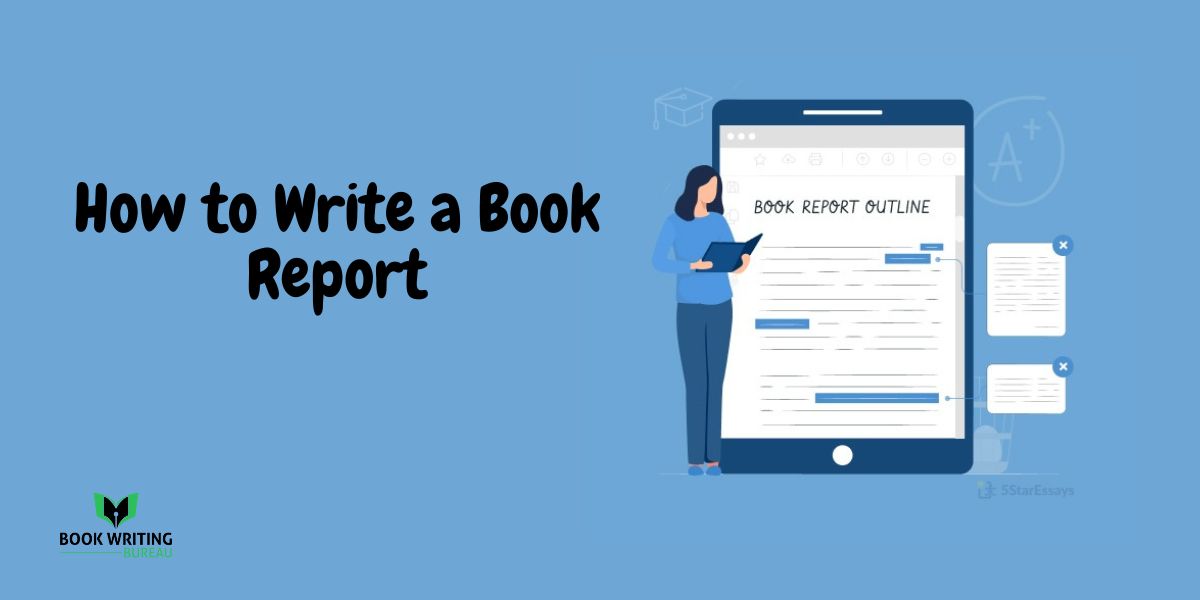
Writing a book report is a common task for students and book enthusiasts alike. However, writing a book report could be daunting for a new author. But with the right approach, writing a book report can be an enjoyable and rewarding experience.
From engaging introductions to thorough analysis and thoughtful reflections, you will learn how to write a compelling book report that showcases your understanding of the book and sharpens your skills as a writer.
According to top eBook writing services in the USA , the idea of condensing thoughts and impressions about a piece of literature can be particularly daunting, yet it is a crucial step in fostering a deeper understanding of storytelling intricacies.
Becoming a new author is an exciting and fulfilling venture, with endless possibilities for storytelling and self-expression.
A book report is a written summary and analysis of a book. It typically includes a brief overview of the plot, a discussion of the characters, an exploration of the themes and messages conveyed in the book, and the reviewer’s reflections and opinions.
Writing a book report aims to demonstrate your comprehension of the book’s content and provide a critical evaluation of its strengths and weaknesses. It allows readers to gain insight into the book without reading it themselves, making it a valuable tool for recommendations and discussions.
Book reports also help readers develop critical thinking skills by encouraging them to analyze and interpret literature.
When writing a book report, providing a balanced and objective analysis is essential while expressing your perspective. Whether you are a student or a new author looking to improve your writing skills, writing book reports can enhance your understanding of storytelling and literary analysis.
It is expected that a book report would have the essential aspects. However, an excellent will focus on a particular subject or viewpoint and provide instances that support this topic via symbols and motifs.
Follow these steps that will help you find and include those crucial features:
If you haven’t been assigned a specific book, choose one that aligns with your interests or academic requirements. Ensure it is appropriate in length and complexity for your assignment.
Before you begin writing, carefully read the book. Take notes on key plot points, book report ideas, characters, themes, and significant quotes. Understanding the nuances of the story, like Investigating Trails Carolina Horror Stories , is crucial for an effective book report.
Familiarize yourself with the specific criteria and guidelines provided for the book report. This may include the required length, format, and any questions or prompts you must address.
If the book report is for a class or a specific purpose, carefully read the assignment guidelines. Pay attention to requirements regarding length, format, and any specific elements the instructor wants you to address.
Organize your thoughts by creating a book report outline. Include the introduction, summary, analysis, reflections, and conclusion sections. This will help maintain a logical flow in your report.
Begin your book report with a compelling introduction. According to book publishers in NYC , include the book’s title, author, publication information, and offer a brief overview of the story’s setting and main characters.
Consider including a hook or an interesting fact about the book to make your introduction compelling.
Include the book’s title, author, and a brief overview of the plot. State your initial thoughts or expectations before reading the book.
In the body paragraphs, provide a concise and accurate summary of the book’s plot. Avoid including excessive details or spoilers; focus on the major events that drive the story forward.
Mention the main conflict, climax, and resolution. Pay attention to the author’s writing style or any unique narrative techniques.
Discuss the main characters in the book. Explore their personalities, motivations, and how they contribute to the story. Comment on character development and any changes they undergo.
Identify and discuss the major themes or messages conveyed in the book. Analyze how these themes are developed throughout the narrative. Consider the author’s intent and the relevance of the themes to the story.
Describe the setting of the story and its significance. Explain how the setting contributes to the overall atmosphere or mood of the book. Note any unique or memorable settings.
Assess the author’s writing style. Discuss whether it was engaging, descriptive, or thought-provoking. Provide examples from the book to support your evaluation. Consider how the writing style contributes to the overall impact of the narrative.
Share your thoughts and reactions to the book. Discuss what you liked or disliked and why. Consider how the book impacted you emotionally or intellectually. This section allows you to express your unique perspective.
Summarize your main points in the conclusion. Restate your overall impression of the book and whether you would recommend it. End with a strong closing statement that leaves a lasting impression.
Before submitting your book report, proofread and edit for grammar, spelling, and clarity. Ensure that your ideas flow logically and that your report is well-organized. Consider seeking feedback from instructors or professional eBook editing services .
Adhere to any formatting guidelines provided in the assignment. This may include specific font, spacing, or citation requirements.
If the assignment calls for it, include a title page with essential information such as your name, the book title, and the publication date. Also, you can consider best ghost writing services for professional suggestions. Additionally, create a bibliography or works cited page if you’ve used external sources.
Title: “The Great Gatsby” by F. Scott Fitzgerald
Introduction:
“The Great Gatsby” by F. Scott Fitzgerald is a classic exploration of the American Dream set against the backdrop of the Roaring Twenties.
In this tale of love, wealth, and societal decadence, Fitzgerald delves into the lives of Jay Gatsby, a mysterious millionaire, and Nick Carraway, the novel’s narrator.
As a new author engaging with this iconic work, the challenge was not merely to summarize the plot but to dissect its nuanced characters and themes.
The novel unfolds through Nick’s eyes as he becomes entangled in the lives of his enigmatic neighbor, Gatsby, and his cousin, Daisy Buchanan. The narrative explores Gatsby’s relentless pursuit of success and love, juxtaposed against the moral disintegration of the era.
Themes of illusion, the corrupting influence of wealth, and the fragility of the American Dream permeate the story.
Fitzgerald’s lyrical prose and vivid imagery create a captivating atmosphere, immersing readers in the luxury and disillusionment of the Jazz Age. The characters, particularly Gatsby, are richly layered, with their flaws and aspirations laid bare. The novel’s exploration of societal expectations and the consequences of unbridled ambition is as relevant today as it was in the 1920s.
Reflection:
As a new author, navigating the intricacies of “The Great Gatsby” provided valuable insights into crafting complex characters and exploring timeless themes. The novel serves as both a cautionary tale and an inspiration, showcasing the enduring power of storytelling to illuminate the human condition.
Title: “Sapiens: A Brief History of Humankind” by Yuval Noah Harari
“Sapiens: A Brief History of Humankind” by Yuval Noah Harari is a thought-provoking journey through the evolution of Homo sapiens, from ancient ancestors to the present. As a new author delving into non-fiction, the task was to convey the author’s ideas, critically engage with the narrative and present a cohesive analysis.
Harari skillfully traces the history of Homo sapiens, exploring the cognitive, agricultural, and scientific revolutions that shaped human societies. The narrative encompasses the rise and fall of empires, the impact of cultural and technological advancements, and the intricate interplay between biology and belief systems.
Harari’s interdisciplinary approach, blending history, anthropology, and biology, offers a comprehensive understanding of human development. The author challenges conventional wisdom and prompts readers to reevaluate familiar narratives. The book encourages critical thinking about the forces that have shaped our collective destiny.
Navigating the labyrinth of “Sapiens” as a new author expanded the horizon of storytelling beyond fiction. Engaging with real-world events and ideas required a different set of analytical skills. Harari’s ability to distill complex concepts into accessible prose serves as inspiration for conveying intricate narratives with clarity and depth.
These examples illustrate how a book report can go beyond summarization, delving into analysis and personal reflection, creating a nuanced understanding of the book and its impact on the reader.
The specific format of a book report can vary depending on the requirements provided by your teacher or professor. However, a common format to write a book report includes an introduction, summary, analysis, and conclusion. Include details such as the book’s title, author, publisher, genre, and publication date.
A cereal box book report is a creative and engaging way for students to present a book they have read. Instead of a traditional written report, the book’s main elements and themes are represented using an empty cereal box. Students decorate the box with illustrations, information about the book, and other relevant details.
The report that shows the book (purchase or cost) value of inventory items with quantity on hand is commonly referred to as an “Inventory Valuation Report” or a “Stock Valuation Report.” This report summarizes the inventory items, their respective quantities on hand, and their associated book values or costs.
When writing a book report in 6th grade, it is important to include key elements such as the book’s title, author, main characters, plot summary, and analysis of themes or messages. Focus on providing a balanced evaluation of the book’s strengths and weaknesses, and support your opinions with examples from the text. Follow any specific instructions given by your teacher.
The length of a book report can vary depending on the specific requirements provided to you. Typically, book reports in 6th grade, like best Christmas books for kids , may range from one to three pages. However, always refer to your teacher’s guidelines or instructions to determine the appropriate length.
Yes, professional writers or any online book writing company can assist you in writing a book report. However, it is important to consider affordable ghostwriting solutions and convey all the policies your educational institution sets. Always check with your teacher or professor to ensure that hiring a writer or using external help is acceptable.
Begin with a clear and engaging introduction that grabs the reader’s attention. Provide a concise summary of the book, highlighting the key elements without giving excessive details.
Use specific examples and evidence from the text to support your analysis. This will demonstrate your understanding of the book and showcase your writing abilities.
Additionally, it is beneficial to include your personal opinions and reflections on the book. Discuss what resonated with you, what you found compelling or thought-provoking, and any criticisms you may have. Again, support your opinions with evidence from the text to give weight to your arguments.
Lastly, conclude your report with a concise summary of your main points and an overall evaluation of the book. Highlight its strengths and weaknesses, and provide closure to your analysis.
limited Time offer
50% off on all services.
REDEEM YOUR COUPON: BWB50
Experienced Authors at Your Service
trust us to help you realize your publishing dreams. Contact us now and let your story shine on the shelves!"
Recommended Blogs

Which Phrases Representing the Idea of Freedom Connect the Poem to The Autobiography?
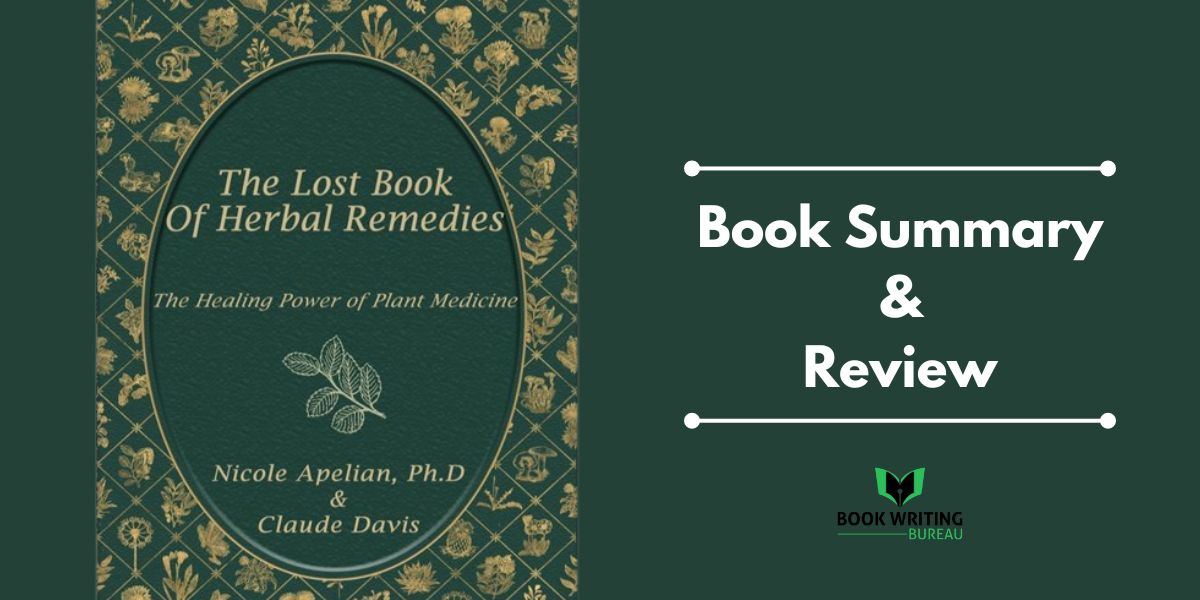
The Lost Book of Herbal Remedies: Book Summary & Review

How to Increase Book Sales On Amazon?

Book Writing Bureau is the USA’s leading book writing service provider that makes you a worthy author. We also offer book publishing, marketing, editing and formatting for authors worldwide.
- E-Book Writing
- Book Cover Design
- Book Video Trailer
- Book Marketing
- Book Publishing
- Ghostwriting
- Audio Books
- Author Website
- Book illustration
- Editing & Proofreading
- Article Writing
- Book Printing
PAYMENT METHODS:
- Rockefeller Center, Plaza District, Midtown West, Corporate Row 1270 Avenue of the Americas @50th Street New York, NY 10017
All Rights Reserved 2023 - Book Writing Bureau
Disclaimer:
All company logos and trademarks appearing on our website are the property of their respective owners. We are not affiliated, associated, endorsed by, or in any way officially connected with these companies or their trademarks. The use of these logos and trademarks does not imply any endorsement, affiliation, or relationship between us and the respective companies. We solely use these logos and trademarks for identification purposes only. All information and content provided on our website is for informational purposes only and should not be construed as professional advice. We do not guarantee the accuracy or completeness of any information provided on our website. We are not responsible for any errors or omissions, or for the results obtained from the use of this information. Any reliance you place on such information is strictly at your own risk.
Discuss Your Project Today!
Avail exclusive discounts, on your upcoming project.

How to Write a Book Report
Use the links below to jump directly to any section of this guide:
Book Report Fundamentals
Preparing to write, an overview of the book report format, how to write the main body of a book report, how to write a conclusion to a book report, reading comprehension and book reports, book report resources for teachers .
Book reports remain a key educational assessment tool from elementary school through college. Sitting down to close read and critique texts for their content and form is a lifelong skill, one that benefits all of us well beyond our school years. With the help of this guide, you’ll develop your reading comprehension and note-taking skills. You’ll also find resources to guide you through the process of writing a book report, step-by-step, from choosing a book and reading actively to revising your work. Resources for teachers are also included, from creative assignment ideas to sample rubrics.
Book reports follow general rules for composition, yet are distinct from other types of writing assignments. Central to book reports are plot summaries, analyses of characters and themes, and concluding opinions. This format differs from an argumentative essay or critical research paper, in which impartiality and objectivity is encouraged. Differences also exist between book reports and book reviews, who do not share the same intent and audience. Here, you’ll learn the basics of what a book report is and is not.
What Is a Book Report?
"Book Report" ( ThoughtCo )
This article, written by a professor emeritus of rhetoric and English, describes the defining characteristics of book reports and offers observations on how they are composed.
"Writing a Book Report" (Purdue OWL)
Purdue’s Online Writing Lab outlines the steps in writing a book report, from keeping track of major characters as you read to providing adequate summary material.
"How to Write a Book Report" ( Your Dictionary )
This article provides another helpful guide to writing a book report, offering suggestions on taking notes and writing an outline before drafting.
"How to Write a Successful Book Report" ( ThoughtCo )
Another post from ThoughtCo., this article highlights the ten steps for book report success. It was written by an academic advisor and college enrollment counselor.
What’s the Difference Between a Book Report and an Essay?
"Differences Between a Book Report & Essay Writing" ( Classroom)
In this article from the education resource Classroom, you'll learn the differences and similarities between book reports and essay writing.
"Differences Between a Book Report and Essay Writing" (SeattlePi.com)
In this post from a Seattle newspaper's website, memoirist Christopher Cascio highlights how book report and essay writing differ.
"The Difference Between Essays and Reports" (Solent Online Learning)
This PDF from Southampton Solent University includes a chart demonstrating the differences between essays and reports. Though it is geared toward university students, it will help students of all levels understand the differing purposes of reports and analytical essays.
What’s the Difference Between a Book Report and a Book Review?
"How to Write a Book Review and a Book Report" (Concordia Univ.)
The library at Concordia University offers this helpful guide to writing book report and book reviews. It defines differences between the two, then presents components that both forms share.
"Book Reviews" (Univ. of North Carolina)
The University of North Carolina at Chapel Hill’s writing guide shows the step-by-step process of writing book reviews, offering a contrast to the composition of book reports.
Active reading and thoughtful preparation before you begin your book report are necessary components of crafting a successful piece of writing. Here, you’ll find tips and resources to help you learn how to select the right book, decide which format is best for your report, and outline your main points.
Selecting and Finding a Book
"30 Best Books for Elementary Readers" (Education.com)
This article from Education.com lists 30 engaging books for students from kindergarten through fifth grade. It was written by Esme Raji Codell, a teacher, author, and children's literature specialist.
"How to Choose a Good Book for a Report (Middle School)" (WikiHow)
This WikiHow article offers suggestions for middle schoolers on how to choose the right book for a report, from getting started early on the search process to making sure you understand the assignment's requirements.
"Best Book-Report Books for Middle Schoolers" (Common Sense Media)
Common Sense Media has compiled this list of 25 of the best books for middle school book reports. For younger students, the article suggests you check out the site's "50 Books All Kids Should Read Before They're 12."
"50 Books to Read in High School" (Lexington Public Library)
The Lexington, Kentucky Public Library has prepared this list to inspire high school students to choose the right book. It includes both classics and more modern favorites.
The Online Computer Library Center's catalogue helps you locate books in libraries near you, having itemized the collections of 72,000 libraries in 170 countries.
Formats of Book Reports
"Format for Writing a Book Report" ( Your Dictionary )
Here, Your Dictionary supplies guidelines for the basic book report format. It describes what you'll want to include in the heading, and what information to include in the introductory paragraph. Be sure to check these guidelines against your teacher's requirements.
"The Good Old Book Report" (Scholastic)
Nancy Barile’s blog post for Scholastic lists the questions students from middle through high school should address in their book reports.
How to Write an Outline
"Writer’s Web: Creating Outlines" (Univ. of Richmond)
The University of Richmond’s Writing Center shows how you can make use of micro and macro outlines to organize your argument.
"Why and How to Create a Useful Outline" (Purdue OWL)
Purdue’s Online Writing Lab demonstrates how outlines can help you organize your report, then teaches you how to create outlines.
"Creating an Outline" (EasyBib)
EasyBib, a website that generates bibliographies, offers sample outlines and tips for creating your own. The article encourages you to think about transitions and grouping your notes.
"How to Write an Outline: 4 Ways to Organize Your Thoughts" (Grammarly)
This blog post from a professional writer explains the advantages of using an outline, and presents different ways to gather your thoughts before writing.
In this section, you’ll find resources that offer an overview of how to write a book report, including first steps in preparing the introduction. A good book report's introduction hooks the reader with strong opening sentences and provides a preview of where the report is going.
"Step-by-Step Outline for a Book Report" ( Classroom )
This article from Classroom furnishes students with a guide to the stages of writing a book report, from writing the rough draft to revising.
"Your Roadmap to a Better Book Report" ( Time4Writing )
Time4Writing offers tips for outlining your book report, and describes all of the information that the introduction, body, and conclusion should include.
"How to Start a Book Report" ( ThoughtCo)
This ThoughtCo. post, another by academic advisor and college enrollment counselor Grace Fleming, demonstrates how to write a pithy introduction to your book report.
"How to Write an Introduction for a Book Report" ( Classroom )
This brief but helpful post from Classroom details what makes a good book report introduction, down to the level of individual sentences.
The body paragraphs of your book report accomplish several goals: they describe the plot, delve more deeply into the characters and themes that make the book unique, and include quotations and examples from the book. Below are some resources to help you succeed in summarizing and analyzing your chosen text.
Plot Summary and Description
"How Do You Write a Plot Summary?" ( Reference )
This short article presents the goals of writing a plot summary, and suggests a word limit. It emphasizes that you should stick to the main points and avoid including too many specific details, such as what a particular character wears.
"How to Write a Plot for a Book Report" ( The Pen & The Pad )
In this article from a resource website for writers, Patricia Harrelson outlines what information to include in a plot summary for a book report.
"How to Write a Book Summary" (WikiHow)
Using Harry Potter and the Sorcerer’s Stone as an example, this WikiHow article demonstrates how to write a plot summary one step at a time.
Analyzing Characters and Themes
"How to Write a Character Analysis Book Report" ( The Pen & The Pad )
Kristine Tucker shows how to write a book report focusing on character. You can take her suggestions as they are, or consider incorporating them into the more traditional book report format.
"How to Write a Character Analysis" (YouTube)
The SixMinuteScholar Channel utilizes analysis of the film Finding Nemo to show you how to delve deeply into character, prioritizing inference over judgment.
"How to Define Theme" ( The Editor's Blog )
Fiction editor Beth Hill contributes an extended definition of theme. She also provides examples of common themes, such as "life is fragile."
"How to Find the Theme of a Book or Short Story" ( ThoughtCo )
This blog post from ThoughtCo. clarifies the definition of theme in relation to symbolism, plot, and moral. It also offers examples of themes in literature, such as love, death, and good vs. evil.
Selecting and Integrating Quotations
"How to Choose and Use Quotations" (Santa Barbara City College)
This guide from a college writing center will help you choose which quotations to use in your book report, and how to blend quotations with your own words.
"Guidelines for Incorporating Quotes" (Ashford Univ.)
This PDF from Ashford University's Writing Center introduces the ICE method for incorporating quotations: introduce, cite, explain.
"Quote Integration" (YouTube)
This video from The Write Way YouTube channel illustrates how to integrate quotations into writing, and also explains how to cite those quotations.
"Using Literary Quotations" (Univ. of Wisconsin-Madison)
This guide from the University of Wisconsin-Madison’s Writing Center helps you emphasize your analysis of a quotation, and explains how to incorporate quotations into your text.
Conclusions to any type of paper are notoriously tricky to write. Here, you’ll learn some creative ways to tie up loose ends in your report and express your own opinion of the book you read. This open space for sharing opinions that are not grounded in critical research is an element that often distinguishes book reports from other types of writing.
"How to Write a Conclusion for a Book Report" ( Classroom )
This brief article from the education resource Classroom illustrates the essential points you should make in a book report conclusion.
"Conclusions" (Univ. of North Carolina)
The University of North Carolina at Chapel Hill’s Writing Center lays out strategies for writing effective conclusions. Though the article is geared toward analytical essay conclusions, the tips offered here will also help you write a strong book report.
"Ending the Essay: Conclusions" (Harvard College Writing Center)
Pat Bellanca’s article for Harvard University’s Writing Center presents ways to conclude essays, along with tips. Again, these are suggestions for concluding analytical essays that can also be used to tie up a book report's loose ends.
Reading closely and in an engaged manner is the strong foundation upon which all good book reports are built. The resources below will give you a picture of what active reading looks like, and offer strategies to assess and improve your reading comprehension. Further, you’ll learn how to take notes—or “annotate” your text—making it easier to find important information as you write.
How to Be an Active Reader
"Active Reading Strategies: Remember and Analyze What You Read" (Princeton Univ.)
Princeton University’s McGraw Center for Teaching and Learning recommends ten strategies for active reading, and includes sample diagrams.
"Active Reading" (Open Univ.)
The Open University offers these techniques for reading actively alongside video examples. The author emphasizes that you should read for comprehension—not simply to finish the book as quickly as possible.
"7 Active Reading Strategies for Students" ( ThoughtCo )
In this post, Grace Fleming outlines seven methods for active reading. Her suggestions include identifying unfamiliar words and finding the main idea.
"5 Active Reading Strategies for Textbook Assignments" (YouTube)
Thomas Frank’s seven-minute video demonstrates how you can retain the most important information from long and dense reading material.
Assessing Your Reading Comprehension
"Macmillan Readers Level Test" (MacMillan)
Take this online, interactive test from a publishing company to find out your reading level. You'll be asked a number of questions related to grammar and vocabulary.
"Reading Comprehension Practice Test" (ACCUPLACER)
ACCUPLACER is a placement test from The College Board. This 20-question practice test will help you see what information you retain after reading short passages.
"Reading Comprehension" ( English Maven )
The English Maven site has aggregated exercises and tests at various reading levels so you can quiz your reading comprehension skills.
How to Improve Your Reading Comprehension
"5 Tips for Improving Reading Comprehension" ( ThoughtCo )
ThoughtCo. recommends five tips to increase your reading comprehension ability, including reading with tools such as highlighters, and developing new vocabulary.
"How to Improve Reading Comprehension: 8 Expert Tips" (PrepScholar)
This blog post from PrepScholar provides ideas for improving your reading comprehension, from expanding your vocabulary to discussing texts with friends.
CrashCourse video: "Reading Assignments" (YouTube)
This CrashCourse video equips you with tools to read more effectively. It will help you determine how much material you need to read, and what strategies you can use to absorb what you read.
"Improving Reading Comprehension" ( Education Corner )
From a pre-reading survey through post-reading review, Education Corner walks you through steps to improve reading comprehension.
Methods of In-text Annotation
"The Writing Process: Annotating a Text" (Hunter College)
This article from Hunter College’s Rockowitz Writing Center outlines how to take notes on a text and provides samples of annotation.
"How To Annotate Text While Reading" (YouTube)
This video from the SchoolHabits YouTube channel presents eleven annotation techniques you can use for better reading comprehension.
"5 Ways To Annotate Your Books" ( Book Riot )
This article from the Book Riot blog highlights five efficient annotation methods that will save you time and protect your books from becoming cluttered with unnecessary markings.
"How Do You Annotate Your Books?" ( Epic Reads )
This post from Epic Reads highlights how different annotation methods work for different people, and showcases classic methods from sticky notes to keeping a reading notebook.
Students at every grade level can benefit from writing book reports, which sharpen critical reading skills. Here, we've aggregated sources to help you plan book report assignments and develop rubrics for written and oral book reports. You’ll also find alternative book report assessment ideas that move beyond the traditional formats.
Teaching Elementary School Students How to Write Book Reports
"Book Reports" ( Unique Teaching Resources )
These reading templates courtesy of Unique Teaching Resources make great visual aids for elementary school students writing their first book reports.
"Elementary Level Book Report Template" ( Teach Beside Me )
This printable book report template from a teacher-turned-homeschooler is simple, classic, and effective. It asks basic questions, such as "who are the main characters?" and "how did you feel about the main characters?"
"Book Reports" ( ABC Teach )
ABC Teach ’s resource directory includes printables for book reports on various subjects at different grade levels, such as a middle school biography book report form and a "retelling a story" elementary book report template.
"Reading Worksheets" ( Busy Teacher's Cafe )
This page from Busy Teachers’ Cafe contains book report templates alongside reading comprehension and other language arts worksheets.
Teaching Middle School and High School Students How to Write Book Reports
"How to Write a Book Report: Middle and High School Level" ( Fact Monster)
Fact Monster ’s Homework Center discusses each section of a book report, and explains how to evaluate and analyze books based on genre for students in middle and high school.
"Middle School Outline Template for Book Report" (Trinity Catholic School)
This PDF outline template breaks the book report down into manageable sections for seventh and eighth graders by asking for specific information in each paragraph.
"Forms for Writing a Book Report for High School" ( Classroom )
In this article for Classroom, Elizabeth Thomas describes what content high schoolers should focus on when writing their book reports.
"Forms for Writing a Book Report for High School" ( The Pen & The Pad )
Kori Morgan outlines techniques for adapting the book report assignment to the high school level in this post for The Pen & The Pad .
"High School Book Lists and Report Guidelines" (Highland Hall Waldorf School)
These sample report formats, grading paradigms, and tips are collected by Highland Hall Waldorf School. Attached are book lists by high school grade level.
Sample Rubrics
"Book Review Rubric Editable" (Teachers Pay Teachers)
This free resource from Teachers Pay Teachers allows you to edit your book report rubric to the specifications of your assignment and the grade level you teach.
"Book Review Rubric" (Winton Woods)
This PDF rubric from a city school district includes directions to take the assignment long-term, with follow-up exercises through school quarters.
"Multimedia Book Report Rubric" ( Midlink Magazine )
Perfect for oral book reports, this PDF rubric from North Carolina State University's Midlink Magazine will help you evaluate your students’ spoken presentations.
Creative Book Report Assignments
"25 Book Report Alternatives" (Scholastic)
This article from the Scholastic website lists creative alternatives to the standard book report for pre-kindergarteners through high schoolers.
"Fresh Ideas for Creative Book Reports" ( Education World )
Education World offers nearly 50 alternative book report ideas in this article, from a book report sandwich to a character trait diagram.
"A Dozen Ways to Make Amazingly Creative Book Reports" ( We Are Teachers )
This post from We Are Teachers puts the spotlight on integrating visual arts into literary study through multimedia book report ideas.
"More Ideas Than You’ll Ever Use for Book Reports" (Teachnet.com)
This list from Teachnet.com includes over 300 ideas for book report assignments, from "interviewing" a character to preparing a travel brochure to the location in which the book is set.
"Fifty Alternatives to the Book Report" (National Council of Teachers of English)
In this PDF resource from the NCTE's English Journal, Diana Mitchell offers assignment ideas ranging from character astrology signs to a character alphabet.
- PDFs for all 136 Lit Terms we cover
- Downloads of 1918 LitCharts Lit Guides
- Teacher Editions for every Lit Guide
- Explanations and citation info for 40,450 quotes across 1918 books
- Downloadable (PDF) line-by-line translations of every Shakespeare play
Need something? Request a new guide .
How can we improve? Share feedback .
LitCharts is hiring!

- Try for free
How to Write a Book Report (+ Book Report Example)
Download for free, specific tips for writing effective book reports..
Write better book reports using the tips, examples, and outlines presented here. This resource covers three types of effective book reports: plot summaries, character analyses, and theme analyses. It also features a specific book report example for students.
How to write a book report (+ book report example)
Whether you're a student looking to show your comprehension of a novel, or simply a book lover wanting to share your thoughts, writing a book report can be a rewarding experience. This guide, filled with tips, tricks, and a book report example, will help you craft a report that effectively communicates your understanding and analysis of your chosen book.
Looking for a printable resource on book reports? See our Printable Book Report Outlines and Examples
What is a book report?
Book reports can take on many different forms. Writing a book review helps you practice giving your opinion about different aspects of a book, such as an author's use of description or dialogue.
You can write book reports of any type, from fiction to non-fiction research papers, or essay writing; however, there are a few basic elements you need to include to convey why the book you read was interesting when writing a good book report.

Types of book reports
Three types of effective book reports are plot summaries, character analyses, and theme analyses. Each type focuses on different aspects of the book and requires a unique approach. These three types of book reports will help you demonstrate your understanding of the book in different ways.
Plot summary
When you are writing a plot summary for your book report you don't want to simply summarize the story. You need to explain what your opinion is of the story and why you feel the plot is so compelling, unrealistic, or sappy. It is the way you analyze the plot that will make this a good report. Make sure that you use plenty of examples from the book to support your opinions.
Try starting the report with a sentence similar to the following:
The plot of I Married a Sea Captain , by Monica Hubbard, is interesting because it gives the reader a realistic sense of what it was like to be the wife of a whaling captain and live on Nantucket during the 19th century.
Character analysis
If you choose to write a character analysis, you can explore the physical and personality traits of different characters and the way their actions affect the plot of the book.
- Explore the way a character dresses and what impression that leaves with the reader.
- What positive characteristics does the character possess?
- Does the character have a "fatal flaw" that gets him/her into trouble frequently?
- Try taking examples of dialogue and analyzing the way a character speaks. Discuss the words he/she chooses and the way his/her words affect other characters.
- Finally, tie all of your observations together by explaining the way the characters make the plot move forward.
In the novel Charlotte's Web , by E. B. White, Templeton the rat may seem like an unnecessary character but his constant quest for food moves the plot forward in many ways.
Theme analyses
Exploring the themes (or big ideas that run throughout the story) in a book can be a great way to write a book report because picking a theme that you care about can make the report easier to write. Try bringing some of your thoughts and feelings as a reader into the report as a way to show the power of a theme. Before you discuss your own thoughts, however, be sure to establish what the theme is and how it appears in the story.
- Explain exactly what theme you will be exploring in your book report.
- Use as many examples and quotations from the book as possible to prove that the theme is important to the story.
- Make sure that you talk about each example or quotation you've included. Make a direct connection between the theme and the example from the book.
- After you have established the theme and thoroughly examined the way it affects the book, include a few sentences about the impact the theme had upon you and why it made the book more or less enjoyable to read.
In the novel Roll of Thunder Hear My Cry , by Mildred Taylor, the theme of racial prejudice is a major catalyst in the story.
How to write a book report

1. Thoroughly read the book
Immerse yourself in the book, taking the time to read it in its entirety. As you read, jot down notes on important aspects such as key points, themes, and character developments.
2. Identify the main elements of the book
Scrutinize the book's primary components, including its main themes, characters, setting, and plot. These elements will form the basis of your report.
3. Formulate a thesis statement
Compose a thesis statement that encapsulates your personal perspective about the book. This should be a concise statement that will guide your analysis and give your report a clear focus.
4. Create a detailed outline
Plan the structure of your book report. This outline should include an introduction, body paragraphs each focusing on a different aspect of the book, and a conclusion.
5. Craft the introduction
The introduction should provide basic information such as the book's title and author, and present your thesis statement. It should engage the reader and make them interested in your analysis.
6. Write the body of the report
In the body of your report, discuss in detail the book's main elements that you identified in step 3. Use specific examples from the text to support your analysis and to prove your thesis statement.
7. Write a strong conclusion
Your conclusion should summarize your analysis, reaffirm your thesis, and provide a closing thought or reflection on the overall book.
8. Review and edit your report
After writing, take the time to revise your report for clarity and coherence. Check for and correct any grammar or spelling errors. Ensure that your report clearly communicates your understanding and analysis of the book.
9. Include citations
If you have used direct quotes or specific ideas from the book, make sure to include proper citations . This is crucial in academic writing and helps avoid plagiarism.
10. Proofread
Finally, proofread your work. Look for any missed errors and make sure that the report is the best it can be before submitting it.

Book report example
Below is a book report example on the novel To Kill a Mockingbird by Harper Lee.
In To Kill a Mockingbird , Harper Lee presents a thoughtful exploration of racial prejudice, morality, and the loss of innocence. Set in the small, fictional town of Maycomb, Alabama, during the Great Depression, the book centers around the Finch family - young Scout, her older brother Jem, and their widowed father, Atticus. Scout's character provides a fresh perspective as she narrates her experiences and observations of the unjust racial prejudice in her town. Her honesty and curiosity, coupled with her father's teachings, allow her to grow from innocence to a more profound understanding of her society's inequalities. The plot revolves around Atticus Finch, a respected lawyer, defending a black man, Tom Robinson, unjustly accused of raping a white woman. As the trial progresses, it becomes clear that Robinson is innocent, and the accusation was a product of racial prejudice. Despite compelling evidence in Robinson's favor, he is convicted, symbolizing the power of bias over truth. The theme of racial prejudice is a significant part of the book. Lee uses the trial and its unjust outcome to critique the racial prejudice prevalent in society. For example, despite Atticus's solid defense, the jury's racial bias leads them to find Robinson guilty. This instance highlights how deeply ingrained prejudice can subvert justice. The book also explores the theme of the loss of innocence. Scout and Jem's experiences with prejudice and injustice lead to their loss of innocence and a better understanding of the world's complexities. For example, Scout's realization of her town's unfair treatment of Robinson demonstrates her loss of innocence and her understanding of societal biases. Overall, To Kill a Mockingbird is a compelling exploration of the harsh realities of prejudice and the loss of innocence. Harper Lee's intricate characters and vivid storytelling have made this book a classic.
The above is an excellent book report example for several reasons. First, it provides a clear, concise summary of the plot without giving away the entire story. Second, it analyzes the main characters, their roles, and their impacts on the story. Third, it discusses the major themes of the book - racial prejudice and loss of innocence - and supports these themes with evidence from the text. Finally, it presents a personal perspective on the book's impact and overall message, demonstrating a deep understanding of the book's significance.
Book report checklist
Always include the following elements in any book report:
- The type of book report you are writing
- The book's title
- The author of the book
- The time when the story takes place
- The location where the story takes place
- The names and a brief description of each of the characters you will be discussing
- Many quotations and examples from the book to support your opinions
- A thesis statement
- The point of view of the narrator
- Summary of the book
- The main points or themes discussed in the work of fiction or non-fiction
- The first paragraph (introductory paragraph), body paragraphs, and final paragraph
- The writing styles of the author
- A critical analysis of the fiction or non-fiction book
Don't forget!
No matter what type of book report you decide to write, ensure it includes basic information about the main characters, and make sure that your writing is clear and expressive so that it’s easy for audiences in middle school, high school, college-level, or any grade level to understand. Also, include examples from the book to support your opinions. Afterward, conduct thorough proofreading to complete the writing process. Book reports may seem disconnected from your other schoolwork, but they help you learn to summarize, compare and contrast, make predictions and connections, and consider different perspectives & skills you'll need throughout your life.
Looking for more writing resources? You can find them in our creative writing center .
Featured Middle School Resources
Related Resources

- How to Cite
- Language & Lit
- Rhyme & Rhythm
- The Rewrite
- Search Glass
How to Write a Nonfiction Book Report
It generally seems easier to write a book report on a fictional book since the plot is often more imaginative with more precise conflicts than that of a nonfiction book. So what if you are assigned a nonfiction book for your book report? There are some simple techniques to keep in mind while writing a report on a nonfiction book, and you may even find the process more enjoyable and edifying than writing a report on fiction.
Carefully read the book you have chosen or been assigned. It is a good idea to mark pieces of information in the book that you may be able to use in your report with a pencil or Post-It notes. It is nearly impossible to write an intelligent essay without reading and understanding the book first.
Structure your essay using an outline. The introduction to your report should include the author's name, year of publication and reason for writing the nonfiction novel, if applicable. Hook the reader in the first sentence with an interesting opening, and summarize in a line or two the main theme of the novel to set up the rest of your report.
Write a couple of body paragraphs describing the importance of the book and the events in the book in a bit more detail. Do not summarize every chapter or simply rehash the entire plot. Instead, try and bring up moments in the book that show the author's overall theme or which emphasize the main events of the book.
Conclude with your own thoughts and feelings about the book you read if you are able to bring your own opinion into the report. Would you recommend this book to others? What is the most interesting thing you learned? Why do you feel this is an important piece of literature?
Things You'll Need
Jordynn McMahon specializes in travel, technology and health articles. She currently works as a marketing specialist in the software industry. McMahon has a B.A. in English from UC Santa Barbara, as well as an M.A. in English literature and composition from San Jose State University.
Book Report Writing
Book Report Writing Guide - Outline, Format, & Topics
15 min read

People also read
Guide to Crafting an Outstanding Book Report Outline
Creative and Excellent Book Report Ideas for Students
Writing a book report can be a challenging task for students at all levels of education. Many struggle to strike the right balance between providing a concise summary and offering insightful analysis.
The pressure to submit a well-structured report often leaves students feeling overwhelmed and uncertain about where to begin. Unlike a book review that is longer and more detailed, the purpose of writing a book report is to summarize what happened in the story.
In this blog, we will learn the book report writing, providing you with step-by-step instructions and creative ideas. Whether you're a reader or just starting your literary journey, this guide will help you write book reports that shine.
So, let's dive in!
- 1. What is a Book Report?
- 2. How to Write a Book Report Outline?
- 3. How to Write a Book Report?
- 4. Book Report Formatting
- 5. Book Report vs. Book Review - How Do they Differ from Each Other?
- 6. Book Report Templates for Different Grades
- 7. How to Write a Book Report for High School?
- 8. How to Write a Book Report for College Level?
- 9. Book Report Examples
- 10. Book Report Ideas
What is a Book Report?
A book report is a written summary and analysis of a book's content, designed to provide readers with insights into the book's key elements. It's a valuable exercise for students, offering a chance to look deeper into a book's characters, and overall impact. Why are book reports important? They serve as a way to not only showcase your reading comprehension but also your critical thinking skills. They help you reflect on the book's strengths and weaknesses, and they can be a great tool to start a discussion.
How to Write a Book Report Outline?
Before you start writing a book report, it's crucial to create a well-organized outline. A book report outline serves as the roadmap for your report, ensuring that you cover all essential aspects. Here's how to create an effective book report outline:
How to Write a Book Report?
Writing an effective book report is not just about summarizing a story; it's a chance to showcase your analytical skills.
Let’s go through the process of creating a compelling book report that will impress your instructor.
How to Start a Book Report
To start a book report follow the steps below:
- Pick the Perfect Book Selecting the right book for your report is the first crucial step. If you have the freedom to choose, opt for a book that aligns with your interests. Engaging with a book you're passionate about makes the entire process more enjoyable.
- Dive into the Pages Reading the book thoroughly is non-negotiable. While summaries and online resources can be helpful, they can't replace the depth of understanding gained from reading the actual text. Take notes as you read to capture key moments and insights.
- Document Key Insights Keeping a physical notebook for jotting down important points and insights is a tried-and-true method. This tangible record allows for quick reference when you're ready to write your report.
- Collect Powerful Quotes Quotes from the book can be the secret sauce that adds weight to your report. Choose quotes that align with your report's themes and ideas. These quotes will serve as evidence to support your analysis and perspective.
- Craft Your Report Outline An book report outline serves as your roadmap for creating a structured and coherent report. Ensure it includes all the vital elements, from basic book information to your in-depth analysis. An organized outline keeps your writing on track.
Writing Your Book Report
Now that you've completed the preliminary steps, it's time to put pen to paper (or fingers to keyboard). Follow these guidelines for an exceptional book report:
- Introduction: Open with a captivating introduction that introduces the book, its author, and your main thesis. This initial "hook" draws readers in and sparks their interest.
- Plot Summary: Concisely summarize the book's plot, including key events, main characters, and the overall narrative. Offer enough information for understanding without revealing major spoilers.
- Analysis: The core of your report, where you dissect the book's themes, characters, writing style, and any symbolism. Back your insights with book quotes and examples, revealing the author's intentions and how they achieved them.
- Conclusion: Summarize your main points, restate your thesis, and share your overall evaluation of the book. End with a thought-provoking statement or recommendation to leave readers engaged and curious.
Book Report Formatting
When it comes to formatting a book report, simplicity and clarity are key. Here's a straightforward guide on the essential formatting elements:
Book Report vs. Book Review - How Do they Differ from Each Other?
The table below highlights how is a book report different from a book review :
What are the SImilarities between Book Report and Book Review?
Here are the things that are added in both a book report and a book review.
- Bibliographic details
- Background of the author
- The recommended audience for the book
- The main subject of the book or work
- Summary of the work and the only difference is that in the review, a critical analysis is also added
Due to the similarities, many students think that both of these are the same. It is wrong and could cost you your grade.
How to Write a Nonfiction Book Report?
Writing a nonfiction book report may seem daunting, but with a few simple steps, you can craft an informative report. Here's a streamlined guide:
- Read Actively: Carefully read the chosen nonfiction book, highlighting key information. For instance, if you're reporting on a biography, mark significant life events and their impact.
- Introduction: Begin with the author's name, the book's publication year, and why the author wrote the book. Create an engaging opening sentence, such as "In 'The Immortal Life of Henrietta Lacks,' Rebecca Skloot delves into the fascinating world of medical ethics."
- Focused Body: Structure the body into three paragraphs, each addressing crucial aspects. For instance, in a report on a science book, one paragraph could cover the book's key scientific discoveries.
- Concluding Thoughts: Share your personal opinion, if applicable. Would you recommend the book? Mention reasons, like "I highly recommend 'Sapiens' by Yuval Noah Harari for its thought-provoking insights into human history."
Writing a nonfiction book report requires adhering to facts but can still be enjoyable with a strategic approach.
How to Write a Book Report without Reading the Book?
Short on time to read the entire book? Here are quick steps to create a book report:
- Consult Summary Websites: Visit websites providing book summaries and analyses. For instance, SparkNotes or CliffsNotes offer concise overviews.
- Focus on Key Details: Select 2-3 crucial aspects of the book, like major themes or character development. Discuss these in-depth.
- Consider a Writing Service: Utilize professional writing services when time is tight. They can craft a well-structured report based on provided information.
- Offer a Unique Perspective: Differentiate your report by approaching it from a unique angle. For example, explore a theme or character relationship that hasn't been extensively covered by peers.
While challenging, writing a book report without reading the book is possible with these strategies.

Tough Essay Due? Hire Tough Writers!
Book Report Templates for Different Grades
Students studying at different levels have different skills and ability levels. Here is how they can write book reports for their respective academic levels.
How to Write a Book Report for an Elementary School?
The following are some book report templates that you can use for your primary or elementary school.

How to Write a Book Report for Middle School
Here are the book report worksheets that you can use to write your middle school book report.

How to Write a Book Report for High School?
Writing a high school book report includes the following steps:
- Read the book thoroughly and with purpose.
- Make an outline before writing the report as a pre-writing step.
- Follow the guidelines and the given format to create the title page for your report.
- Add basic details in the introduction of your book report.
- Analyze the major and minor characters of the story and the role they play in the progress of the story.
- Analyze the major and significant plot, events, and themes. Describe the story and arguments and focus on important details.
- Conclude by adding a summary of the main elements, characters, symbols, and themes.
How to Write a Book Report for College Level?
Follow this college book report template to format and write your report effectively:
- Understand the Assignment: Familiarize yourself with the assignment and book details to ensure proper adherence.
- Read Thoroughly: Read the book attentively, noting essential details about the plot, characters, and themes.
- Introduction: Craft an informative introduction with bibliographic details.
- Summary: Summarize key aspects like setting, events, atmosphere, narrative style, and the overall plot.
- Plot: Cover the entire story, highlighting essential details, plot twists, and conflicts.
- Conclusion: Summarize the story and assess its strengths and weaknesses. Unlike a review, a book report provides a straightforward summary.
Book Report Examples
Book Report of Charlie and the Chocolate Factory
Book Report of Harry Potter and the Sorcerer’s Stone
Paper Due? Why Suffer? That's our Job!
Book Report Ideas
Basic ideas include presenting your narrative and analysis in simple written form, while more creative ideas include a fun element. Some notable books to choose from for your book report writing assignment are mentioned below:
- "To Kill a Mockingbird" by Harper Lee
- "1984" by George Orwell
- "The Great Gatsby" by F. Scott Fitzgerald
- "Pride and Prejudice" by Jane Austen
- "The Catcher in the Rye" by J.D. Salinger
- "The Lord of the Rings" by J.R.R. Tolkien
- "Harry Potter and the Sorcerer's Stone" by J.K. Rowling
- "The Hunger Games" by Suzanne Collins
- "The Diary of Anne Frank" by Anne Frank
- "The Hobbit" by J.R.R. Tolkien
Need more ideas? Check out our book report ideas blog to get inspiration!
To Sum it Up! Crafting a good book report involves striking the right balance between introducing the book, summarizing its key themes, and avoiding spoilers. It's a delicate art, but with the right guidance you can grasp this skill effortlessly.
Need expert assistance with writing your book report? MyPerfectWords.com is here to help you out!
If you're asking yourself, "Can someone write my essays online ?"Our professional writers have the answer. We can write a custom book report according to your personalized requirements and instructions. Get a high-quality book report to help you earn the best grades on your assignment.
Frequently Asked Questions
What are the parts of a book report.
A book report often contains different sections that describe the setting, main characters, and key themes of the story. A common type is an expository one which details what happened in detail or discusses how people feel about it.
Is a report a summary?
No, a summary is more detailed than a book report. A book report is usually based on a short summary of the book, while a standalone summary is more detailed and could have headings, subheadings, and supporting quotes.
How many paragraphs should be included in a book report?
The book report is a typical assignment in middle and high school, usually with one introduction, three body, and one conclusion paragraph.
The number of paragraphs could vary depending on the academic level, with an expert or professional book report having more than three body paragraphs.
How long is a book report?
It should not exceed two double-spaced pages, be between 600 and 800 words in length. Your book report is a written reflection on the content of a novel or work of nonfiction.
How do you end a book report?
Sum up your thesis statement and remind the readers of the important points, one final time. Do not add any new ideas or themes here and try to leave a lasting impression on the reader.

Write Essay Within 60 Seconds!

Dr. Barbara is a highly experienced writer and author who holds a Ph.D. degree in public health from an Ivy League school. She has worked in the medical field for many years, conducting extensive research on various health topics. Her writing has been featured in several top-tier publications.

Paper Due? Why Suffer? That’s our Job!
Keep reading

- Skip to primary navigation
- Skip to main content
- Skip to primary sidebar
- Skip to footer
Raise the Bar Reading
A Reading Teacher's Blog
Nonfiction Book Report Templates and Ideas for 3rd, 4th and 5th Grade Students
Generally, when we think of book reports, we think of fiction reading response. However, nonfiction book report templates serve equally as important of a purpose for digging deep into nonfiction texts.
Book reports are such a great way to encourage the use of many different reading skills with the same text. With one nonfiction text, students can practice skills like identifying main idea and details, analyzing text structure, finding nonfiction text features, summarizing, quoting, paraphrasing, finding the author’s purpose, citing text evidence, etc. The list goes on and on!
By allowing students to practice so many skills at once, they are able to deeply analyze the text and think critically about the topic. Students can then form their own opinions on the topic and the author’s writing style, and ask important questions for further investigation.
1. BACKPACK BOOK REPORT:
Backpack Book Reports are an engaging, hands-on twist on a classic book report. They are very easy to prep and make a great bulletin board display when completed.

Each page focuses on an important nonfiction reading skill. These include:
- Main Idea & Supporting Details
- Summarizing
- Nonfiction Text Features
- Author’s Point of View & Text Evidence
- Text Structure
- Academic Vocabulary
- Interesting Facts
- Back Up Opinions
- Reflection (What I Learned, My Connection, Questions I Still Have)
2. BOOK REPORT TAB BOOKS:
These tab books really bring nonfiction texts to life! Students re-create the cover of their informational book on the front of their book report. Then, each of the 10 tabs represent an important nonfiction reading response skill. The tabs include:

They also come in full page option to maximize student writing space, or half page size to maximize wall space for a display.

3. INFORMATIONAL TEXT LAP BOOK REPORT:
These lap books are great in that you can have students 1.) completely design their own lap books, or 2.) provide them with more structured directions.
- Lap Book Free-Writes: The teacher tells students what nonfiction elements they are responsible for reporting on, but does not tell them exactly how to present them. The teacher provides students tools like paper, envelopes, scissors, etc. and students can present the information however they would like.

- Structured Lab Book: With this option, the teacher can set clear expectations and provide a model for how to present each nonfiction element on their lap books.
4. NONFICTION BOOK REPORT TEMPLATES:
Students can fill in each template and staple them together with the included cover page. These 10 templates are versatile in that if there’s a skill you haven’t yet covered, you can easily leave that page out until later into the school year and it won’t affect the finished book report product.

5. DIGITAL NONFICTION BOOK REPORT TEMPLATES:
These digital slides are the same as the nonfiction book report templates above, just in a digital Google Slides format. With this format, teachers can just delete any of the slides that cover skills that their students are unfamiliar with before making them their own copy.

6. CEREAL BOX BOOK REPORT IDEAS:
Cereal boxes are a popular 3D way to have students present their book report since cereal boxes are easily accessible for any student to get their hands on. Students cover their boxes with paper to create drawing and writing space.
The front of the box is transformed into a type of cereal that is fitting for the text they read. For example, a student reporting on owls might name their box “Hoot Loops”. Then, the back and sides of their box are filled with information on the text.
Similar to the lap book options described above, it is up to the teacher in how much structure they want to provide in this activity. Students can follow a model of how to present each element of nonfiction, or come up with their own ways to present each element on their box.
7. ONE PAGE BOOK REPORT (One Pager) :
Not every single book report we assign needs to take up tons of class time. A one-page book report option is an essential resource as it can be used as a quick, zero prep assessment tool. Although short, this type of report can still have students dig deep into reading comprehension.

On the one pager that is pictured, students still use many important nonfiction skills. These include writing a nonfiction summary, identifying text structure, finding facts, giving an overall opinion, writing a recommendation, reflection on what they learned, and providing a rating.
8. PARAGRAPH WRITING WITH GUIDELINES:
If you are looking for a way to provide a lot of structure and clear expectations, you can give students a nonfiction book report writing rubric for what their reports need to include from the very start.

Students can also use graphic organizers that break down necessary points to include according to their rubric. Using a graphic organizer for prewriting is a great support for students in organizing their ideas before jumping into their drafts.
No matter what book report format you go with, it is important that students know and understand what is expected of their writing content. Displaying a Nonfiction Book Report Bulletin Board is such a helpful way to provide students with steps to writing a book report as well as terms they will come across in their templates.

All of the nonfiction book report templates from this blog post are included in the Nonfiction Book Reports Bundle as well as the Fiction & Nonfiction Book Reports Megabundle !
Next up: Fiction Book Report Writing Ideas
Teaching Book Report Writing: Book Report Ideas and Formats (Grades 3-5)
Copyright 2021 Raise the Bar Reading
Customized by Laine Sutherland Design
Non-Fiction Book Report Template
Description
Streamline your book report writing with our pre-made template! Cover all the crucial aspects of the book including plot summary, character analysis, and personal opinions. A must-have resource for efficient and effective reporting.
Terms of use apply.
Open with Kami to
Add text, images and videos
Leave interactive annotations
Collaborate in real-time
Assign to students
Edit in offline mode
Related Templates
Hamburger Writing Template
Our hamburger essay template guides you to structure your thoughts and ideas with a clear intro, body, and conclusion.
Newspaper Template
Introduce your students to the world of journalism with this newspaper template. It can be used as a starting point for writing about current events or for publishing their own articles.
The Solar Eclipse Reading Comprehension
Learn about solar eclipses and test your comprehension with this worksheet.
Cursive Handwriting Worksheet | Sentences
Our captivating handwriting worksheet is designed to enhance penmanship skills for younger learners.
Explore Kami Library
Tap the on any templates you'd like to mix and match as a new file, totally free.
Download any templates for your K-12 classroom
Ready-to-use
100% accessible, no sign-in needed
Kami-compatible
Use Kami to personalize, assign and grade
Purdue Online Writing Lab Purdue OWL® College of Liberal Arts
Writing a Book Report

Welcome to the Purdue OWL
This page is brought to you by the OWL at Purdue University. When printing this page, you must include the entire legal notice.
Copyright ©1995-2018 by The Writing Lab & The OWL at Purdue and Purdue University. All rights reserved. This material may not be published, reproduced, broadcast, rewritten, or redistributed without permission. Use of this site constitutes acceptance of our terms and conditions of fair use.
Book reports are informative reports that discuss a book from an objective stance. They are similar to book reviews but focus more on a summary of the work than an evaluation of it. Book reports commonly describe what happens in a work; their focus is primarily on giving an account of the major plot, characters, thesis, and/or main idea of the work. Most often, book reports are a K-12 assignment and range from 250 to 500 words.
Book reviews are most often a college assignment, but they also appear in many professional works: magazines, newspapers, and academic journals. If you are looking to write a book review instead of a book report, please see the OWL resource, Writing a Book Review .
Before You Read
Before you begin to read, consider what types of things you will need to write your book report. First, you will need to get some basic information from the book:
- Publisher location, name of publisher, year published
- Number of Pages
You can either begin your report with some sort of citation, or you can incorporate some of these items into the report itself.
Next, try to answer the following questions to get you started thinking about the book:
- Author: Who is the author? Have you read any other works by this author?
- Genre: What type of book is this: fiction, nonfiction, biography, etc.? What types of people would like to read this kind of book? Do you typically read these kinds of books? Do you like them?
- Title: What does the title do for you? Does it spark your interest? Does it fit well with the text of the book?
- Pictures/Book Jacket/Cover/Printing: What does the book jacket or book cover say? Is it accurate? Were you excited to read this book because of it? Are there pictures? What kinds are there? Are they interesting?
As You Read
While reading a work of fiction, keep track of the major characters. You can also do the same with biographies. When reading nonfiction works, however, look for the main ideas and be ready to talk about them.
- Characters: Who are the main characters? What happens to them? Did you like them? Were there good and bad characters?
- Main Ideas: What is the main idea of the book? What happens? What did you learn that you did not know before?
- Quotes: What parts did you like best? Are there parts that you could quote to make your report more enjoyable?
When You Are Ready to Write
Announce the book and author. Then, summarize what you have learned from the book. Explain what happens in the book, and discuss the elements you liked, did not like, would have changed, or if you would recommend this book to others and why. Consider the following items as well:
- Principles/characters: What elements did you like best? Which characters did you like best and why? How does the author unfold the story or the main idea of the book?
- Organize: Make sure that most of your paper summarizes the work. Then you may analyze the characters or themes of the work.
- Your Evaluation: Choose one or a few points to discuss about the book. What worked well for you? How does this work compare with others by the same author or other books in the same genre? What major themes, motifs, or terms does the book introduce, and how effective are they? Did the book appeal to you on an emotional or logical way?
- Recommend: Would you recommend this book to others? Why? What would you tell them before they read it? What would you talk about after you read it?
Revising/Final Copy
Do a quick double check of your paper:
- Double-check the spelling of the author name(s), character names, special terms, and publisher.
- Check the punctuation and grammar slowly.
- Make sure you provide enough summary so that your reader or instructor can tell you read the book.
- Consider adding some interesting quotes from the reading.

- Featured Articles
- Report Card Comments
- Needs Improvement Comments
- Teacher's Lounge
- New Teachers
- Our Bloggers
- Article Library
- Featured Lessons
- Every-Day Edits
- Lesson Library
- Emergency Sub Plans
- Character Education
- Lesson of the Day
- 5-Minute Lessons
- Learning Games
- Lesson Planning
- Subjects Center
- Teaching Grammar
- Leadership Resources
- Parent Newsletter Resources
- Advice from School Leaders
- Programs, Strategies and Events
- Principal Toolbox
- Administrator's Desk
- Interview Questions
- Professional Learning Communities
- Teachers Observing Teachers
- Tech Lesson Plans
- Science, Math & Reading Games
- Tech in the Classroom
- Web Site Reviews
- Creating a WebQuest
- Digital Citizenship
- All Online PD Courses
- Child Development Courses
- Reading and Writing Courses
- Math & Science Courses
- Classroom Technology Courses
- Classroom Management
- Responsive Classroom
- Dr. Ken Shore: Classroom Problem Solver
- Worksheet Library
- Highlights for Children
- Venn Diagram Templates
- Reading Games
- Word Search Puzzles
- Math Crossword Puzzles
- Geography A to Z
- Holidays & Special Days
- Internet Scavenger Hunts
- Student Certificates
Newsletter Sign Up
Search form
Make writing a book report on a work of non-fiction a little easier with this template.
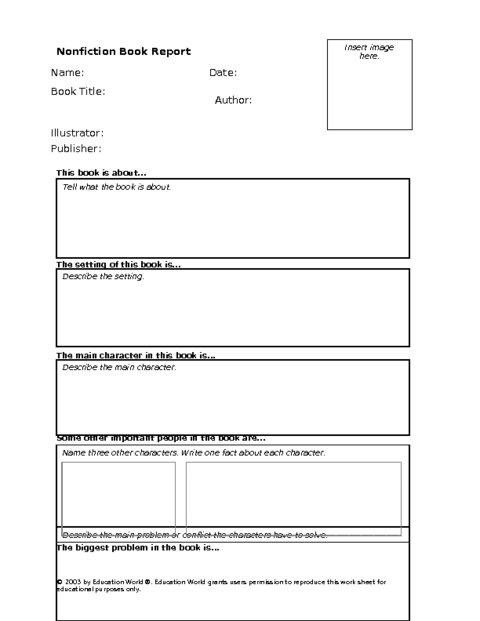
Click here: bookreport_nonfiction-download.doc to download the document.

EW Lesson Plans


EW Professional Development
Ew worksheets.

Sign up for our free weekly newsletter and receive
top education news, lesson ideas, teaching tips and more!
No thanks, I don't need to stay current on what works in education!
COPYRIGHT 1996-2016 BY EDUCATION WORLD, INC. ALL RIGHTS RESERVED.
COPYRIGHT 1996 - 2024 BY EDUCATION WORLD, INC. ALL RIGHTS RESERVED.
- SchoolNotes.com
- The Educator's Network

Over 6,200 homeschool resources and growing!

33 Free Book Report Forms and Templates for Kids
Published: April 11, 2019

Contributor: Annette Breedlove
Disclosure: This post may contain affiliate links, meaning if you decide to make a purchase via my links, I may earn a commission at no additional cost to you. See my disclosure for more info.
I loved writing book reports growing up. My kids, however, do not share the same sentiment. They love to read books and retell the stories to me, but they have a disconnect when it comes to putting it down on paper. That’s why I love using a free book report template to give them a little extra help.

Fun Book Report Ideas
There are many different ways children can share about a book they read other than writing about it. Check out all of these fun ideas:
- Act it out. Young students and even older students may enjoy acting out a story that they read in lieu of writing about it.
- Make a 3D diorama . This is a great way for students who like to work with their hands and create visuals.
- Draw it out on a poster . For young kids who don’t have strong writing skills yet, drawing out what they read is a great option.
- Make a comic book with a free comic book template we have included below.
- Oral narration . Narrating back a brief summary of the book they read is another alternative to writing a book report. You can see if your children comprehended what they read or at least got the main points of the story by asking them basic questions about the book.
Types of Book Reports
If you prefer using book reports, they come in a variety of types and styles. You can write plain-Jane ones or get a little more creative, like the comic strip option below for a different way to format a book report. Whichever you choose, having the option to use a book report template can be helpful for kids.
While I enjoy book reports and see their value, I much prefer my kids enjoy reading a lot of books and sharing, over the finer points of proper form. So if we can use a simple book report template to keep them excited about reading and not dread the reports, I call that a win-win.
Mix it up with the different types of book reports that you assign to your children. Keep it fun and engaging and they will want to read more books and tell everyone about what they have read.
Using Book Report Templates
As with anything we print out for school, I like to find cute printables with book report designs and age-appropriate graphics. This is especially for my middle school-aged daughter, who thinks some of the free worksheets I find are too childish.
Using a book report template for 3rd grade might look a little different than what I’d want to use for 7th grade. A pdf book report template for high school students definitely needs to be less kid-friendly and more informative.
There are simple book report templates for beginning writers and more advanced ones. The options are endless when it comes to choosing a book report template for your homeschool children.
Printable Book Report Forms
Whether you are looking for a short book report template or one for high school, book report templates will help students get their thoughts on paper. They will learn to organize their thoughts so that their finished book report project is a success!
Book report templates can encourage all the readers in your homeschool to crank out an organized, thorough book report that they are proud of! Once you select a free template, you can get started. Let your children choose one of their favorite books for their first report as it will help to keep them engaged.
How to Use a Book Report Template
When you are looking for the perfect book report template, keep in mind the age of your child. Some one-page forms are perfect for young children and beginning readers with boxes to draw, lines to write down main characters, setting, the plot, etc.
When you have a high school student needing to write a paper or a book report, you obviously need something more in-depth. A book report template can help them get their ideas on paper well enough to organize thoughts and personal opinions for an essay, or even a research paper.
The key point of using worksheets for book reports is to have an easy way to get thoughts on paper. A book report template can help your student stay organized so they are able to draft a well-written paper. These types of graphic organizers make book reports a breeze!
What’s included in a book report?
- A good book report will consist of the book title, author’s name, main idea, main theme, plot points and important details.
- It will explain the narrative and setting, and cover the main elements of the story as well as describe important characters of the book.
- You’ll also want to include details on the time period, major conflicts and the book details, or rather a plot summary of the book.
- Don’t forget to include unusual facts and key elements that stand out.
Character Description
Besides adding basic details about the key characters in the book, it’s a good idea to include character details. You will want to include details such as; appearance, interests, and list out some adjectives that describe characters on the book report form .
Analyze what your character looks like so the reader of the book report gets a vivid description of the character. What color is their hair and skin? What is their clothing style like? Do they have a best friend or an animal that is constantly with them?
Is the character an animal? If so, what type of animal are they and what do they look like?
Character Development
Characters develop on in the story as you read about them. Make sure to make note of positive and negative character traits and how those change throughout the plot. Is there a hidden message or reason why the character is behaving the way that they are?
Make notes of how your character has changed and why you think they changed and the reasons for the actions that they took. You can take it a step further and explain how their actions either harmed or helped the story to move along.
Printable Book Report Templates and Forms
If you want a book report template quickly, simply scroll to the bottom of this post to download ours FREE.
DIY Book Report Kit {works with ANY book} This printable book report template is more like a graphic organizer , in my opinion. You can print several different template pages to organize different aspects of the book so you can create a great book report.
Free Book Report Template for Elementary Students Get your 1st -4th graders writing book reports with ease with these pdf book report pages.
Book Review Templates This cute pack of 5 different book report template pages would be perfect for early learners who know how to write .
Printable Book Report Form I like this simple book report template that’s perfect for a new reader. The free printable book report template is organized and will prompt your kids to be creative.
Elementary Book Reports Made Easy An easy one-page pdf download of a book report worksheet that would be good for elementary students.
Printable Book Report Forms (Non-Fiction, Fiction, Biography, Mystery & Fable) You have lots of different options for book report templates. Whether or not you need a book report form for a biography, non-fiction resource , or even a fable, there are several different pdf templates to choose from. There are also multiple book report poster forms for those kids who prefer to draw.
7 Different Versions of Book Report – If you are looking for different versions for different age levels or grades then these reports are worth reviewing.
Easy Book Report – This features an easy form for younger students as well as outline form for older students.
Book Report Templates for Younger Students
There are different styles of book report templates that you will want to focus on for younger students. A book report template that you use with your middle school aged child will be too difficult for beginning writers.
You will want to look for a book report format with dashed lines, boxes to draw a picture in, and more.
My Book Report Worksheets These book report worksheets are suitable for children in kindergarten or first grade.
Comic Strip Book Reports If you have a reluctant writer , or a comic book lover, these free printable comic strip book report templates will likely make a book report less dreaded!
Reading Logs and Bookmarks
Reading Log and Book Report Templates If you are on the hunt for cute reading log printables, these are perfect for elementary students. There are a few different templates that offer options to rate the book and write a review. Using a creative book report template like this might take the sting out of writing book reports for reluctant writers.
Free Reading Log and Book Report Forms My Joy-Filled Life has a 2-page book report template and a printable reading log that you can slip into your homeschool binder .
Free Reading Logs, Bookmarks and Charts – Encourage your readers with fun and colorful bookmarks and charts that they can use to track their reading time as well as the books they have read. Free Instant Download included!
Book Report Template
Book reports don’t have to be boring or something that your children dread. They may be overwhelmed because it is a new thing that they have never done before and may need just a little guidance to get started.
Our FREE DIY Book Report template pack includes four pages of graphic organizers, question prompts, illustration boxes, and more. It is a great start to guiding your children on how to write a book report in a non-threatening way.
You can download it for free in our subscriber library .
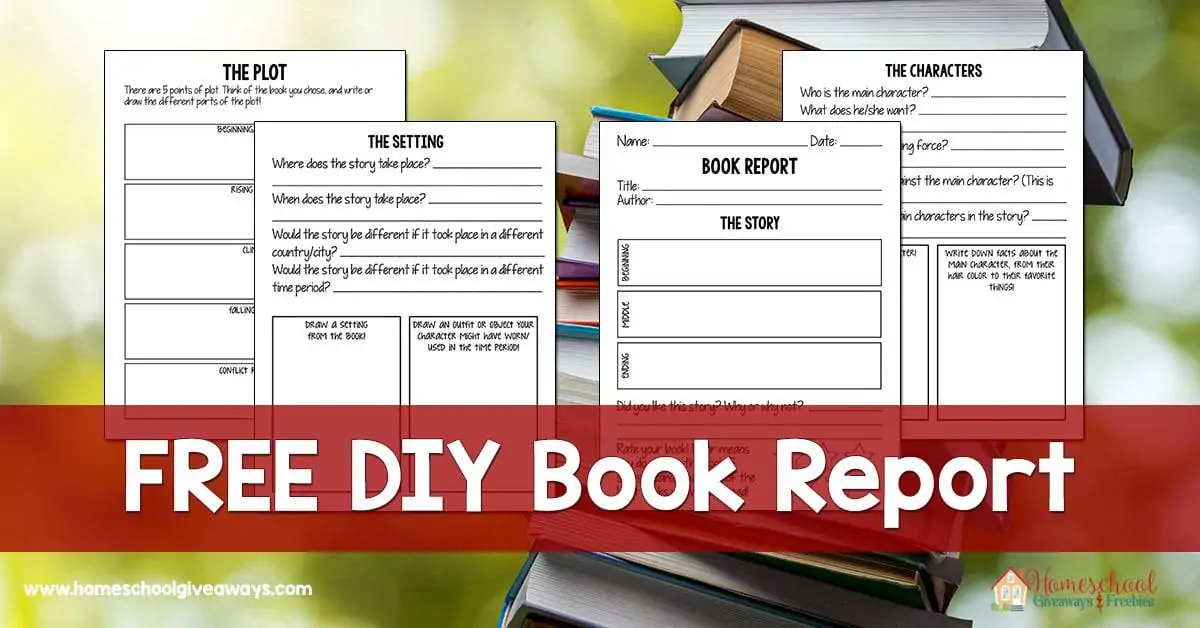
In Conclusion
The body of the book report should include the title, the author of the book, characters, setting, major conflicts, direct quotes, and plot. The conclusion can include a personal opinion. Book reports are a fun way to develop critical thinking skills and teach students how to gather information to format into a writing assignment.
Annette Breedlove
Annette has been married to her husband and best friend since 2003. Together they are raising their six children to follow the Lord’s will, no matter what. Annette longs for the day when she will meet her angel babies who have entered heaven before her. She enjoys creating UNIT STUDIES and FREE PRINTABLES for homeschool families. You can follow her crazy life at In All You Do where she blogs about homeschooling, homemaking and marriage while trying to maintain her sanity. She is also the owner of Thrifty Homeschoolers where she shares her tips on homeschooling without breaking the bank.
Related resources
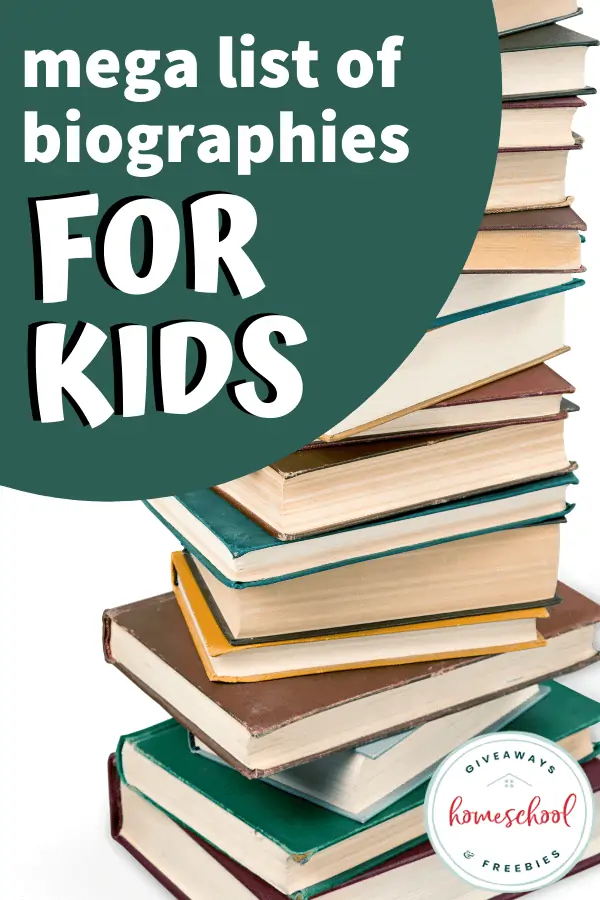
Mega List of Biographies for Kids
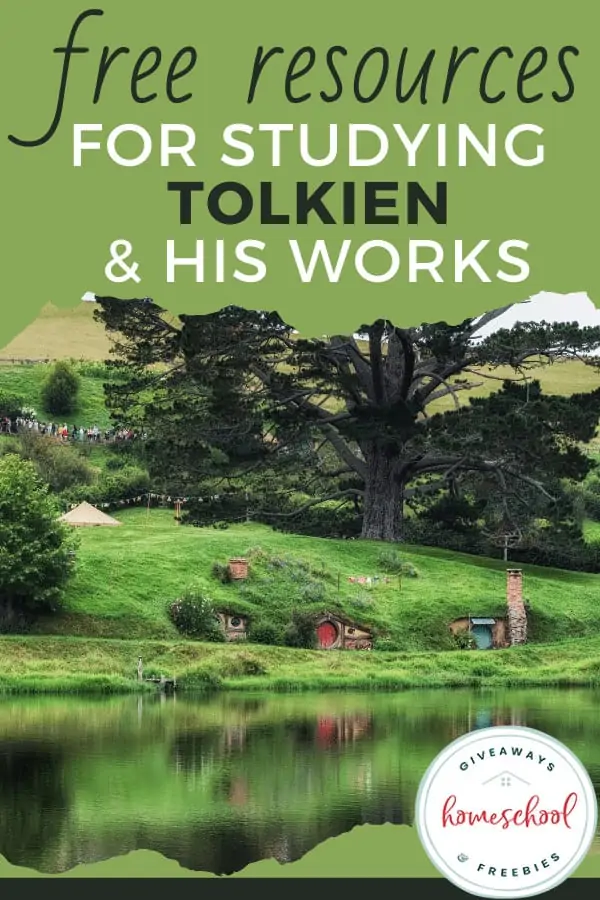
Free Resources for Studying Tolkien & His Works

Free Resources for Studying C.S. Lewis & His Works
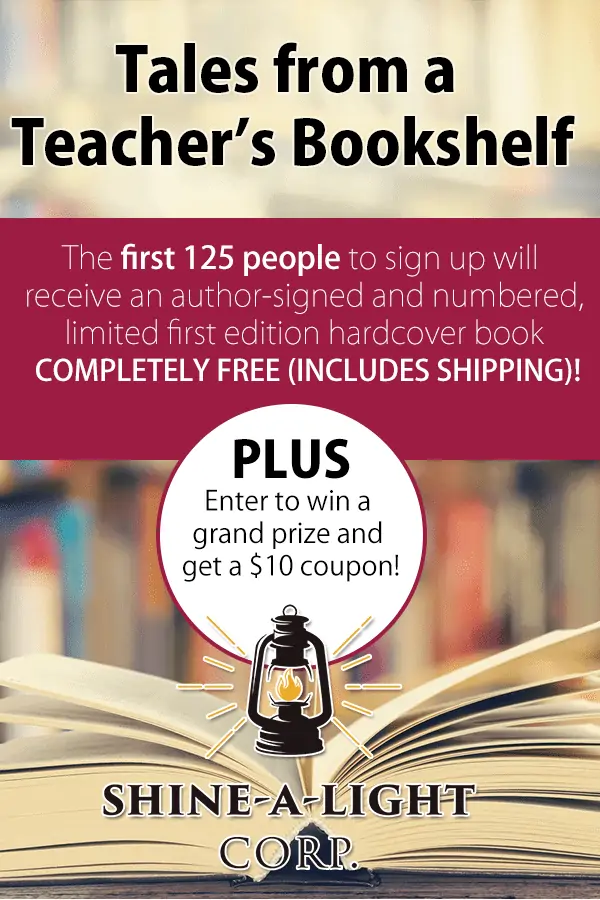
Tales from a Teacher’s Bookshelf + FREE Hardcover Book (Limited) & Giveaway

Mega List of Mystery Books for Kids
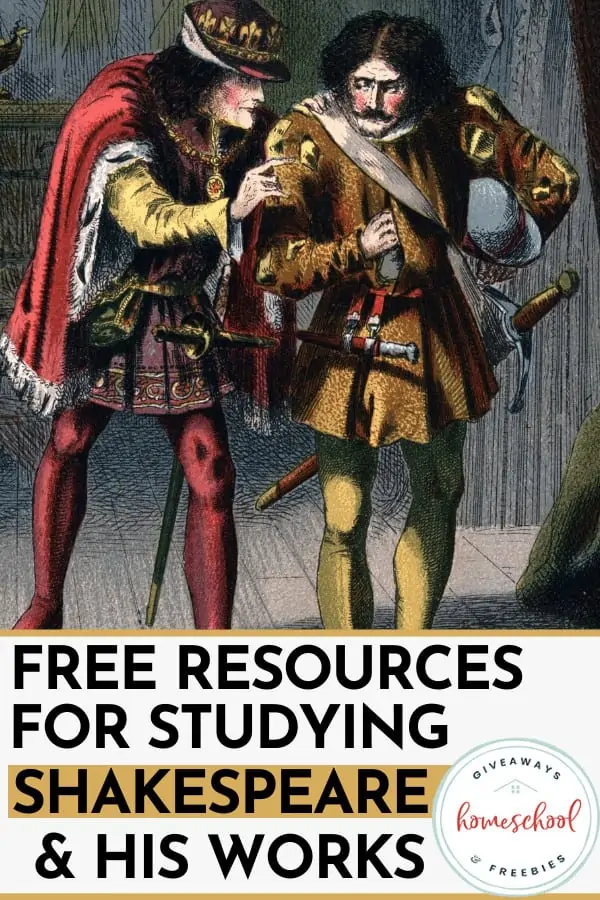
Free Resources for Studying Shakespeare & His Works

- Translators
- Graphic Designers
Please enter the email address you used for your account. Your sign in information will be sent to your email address after it has been verified.
How to Write Outstanding College Level Book Reports

There's nothing quite like enjoying a really solid piece of literature. Hours can pass while you're diving into a new world that the author has created. Your enjoyment of your novel may dissipate slightly when you are trying to figure out how to write a college level book report about it—but it doesn't have to be that way. Analyzing (and maybe even critiquing) novels is a useful skill that will help you both in and outside of the classroom. In this post we will outline the best strategies of painlessly writing a book report. It's important to note that there is no one generic book report assignment. This isn't necessarily a step-by-step guide, but it can help get you started thinking about the specific requirements that your instructor has for you.
Know the assignment
When you start out your book report assignment, it's important that you know exactly what your instructor is requiring. Does your instructor want you to explore the book's theme and write a five-paragraph essay on it, or are you supposed to be writing an essay about a particular character? Read through the assignment sheet very carefully and make sure that you understand all of the instructions. If you have questions or are uncertain about something, be sure to ask your instructor.
Actually read the book
Even though it may be tempting to take a shortcut and watch a movie adaptation of your book or even to read the Sparknotes , definitely resist that urge. Not only will your report be more thorough if you read the book the whole way through, but reading and understanding themes and outlining a novel plot is an invaluable experience. You'll be able to understand books on a completely new and more appreciative level. When you are reading the novel for your book report, write down page numbers or passages that pertain to the assignment or that you think might be interesting to mention.
Try to really sink into what the author is trying to say by asking yourself the following questions:
- What is the main theme of the book? The theme is the meaning or the entire reason behind writing the book. An author doesn't typically write just to write something down. What motivated them to pen this novel?
- What is happening to the characters? Typically novels are told from the perspective (either in the first or third person) of the main character, though some novels have multiple perspectives. Is this character a good character or are they flawed? What kinds of obstacles is the character going through? What did they learn during the course of the story?
- What is the plot of the book? There are several different kinds of plots, and it's helpful to know what kind your chosen novel has in order to help you analyze it better. Some stories are quests: that is, the main character is on a journey to accomplish a goal (think Lord of the Rings). Some stories are overcoming obstacles—whether that's internal or external. What kind of plot does your novel have and why do you think the author chose that particular type?
Write a good introduction
After you've read your book thoroughly and you've thought about the characters, themes, plot, and some good quotes, you'll be ready to start writing the book report. Like any other paper, a good book report needs an explanatory introduction that is easy to understand. When writing the introduction, be sure to include the title of the work, the author, and a sentence or two on what you will be overviewing in the report. Even though it may not be required to have a thesis statement in your book report, writing one in your paper might keep it more focused and help you narrow down what you will be writing in the body paragraphs.
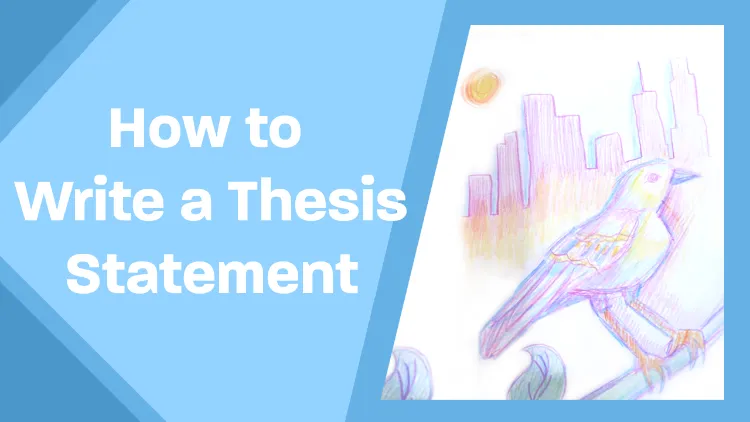
For example, if we were writing an introduction about a book report over Harper Lee's To Kill a Mockingbird , we might write something like this:
In Harper Lee's iconic coming of age novel, To Kill a Mockingbird, Lee confronts the audience with the idea that systemic racism was rampant in the U.S. court system in the early 20th century in the South. She illustrates this idea with the unfair trial of convicted rapist Tom Robinson, whose lawyer Atticus Finch handily proves is innocent, yet is still sentenced with a crime he did not commit. Through the eyes of the young main character, Scout Finch, the audience is able to learn about these injustices with the innocent eyes of a child.
As you can see, we mentioned the name of the book, the author, and we also outlined what we would be discussing throughout the body paragraphs in the book report. Not only will this let the reader know what this report is about, but it'll also help you stay organized when you are writing the paper. Note that nowhere in this paragraph does it say that we really liked the book. Whether or not we liked the book is irrelevant in the report. What the book report is trying to do is to objectively understand a book's relevance and importance wit themes, characters, motifs, etc. (Though of course it's perfectly okay and encouraged to like the book that you are reviewing.)
Implement the ideas in the body paragraphs
The meat of your book report will be in the body paragraphs. These paragraphs will expand on the ideas that you brought up in your introduction paragraph and allow you to introduce the novel in depth to your reader.
Though no two book report assignments are the same, it's likely that your instructor is going to want to see some summarization in your book report. Your summary of the novel shouldn't be too lengthy (this is a report after all, so it's typically quite short). If your instructor has assigned a five-page book report, don't summarize the book in four and a half pages. As a general rule, commit about 1/3 of the paper to a summary just so you can make sure the reader understands your analysis of it without having read it.
Once you are done writing the summary of the novel, then you can get into your actual analysis of it. You may remember that we brought up systemic racism in the U.S. court system in the South in our essay on To Kill a Mockingbird. In our summary, we would then explore those ideas that we brought forth to the reader. How does Lee illustrate this idea throughout the novel? A good way to show how the author is making this point is through direct quotations from the book that you believe are a good showcase.
In your analysis, you should also be discussing theme (or what was the author's purpose behind writing this book) and character. No two analyses are the same, which is what makes book reports and literary criticism so interesting. Everyone will read the novel through their own personal lenses and experiences and come up with a completely different interpretation of what the author intended for us to come away with.
Again, it's crucial to keep looking at your instructions for your book report so that you know exactly what you need to be discussing. Even if you write a brilliant report over the theme of systemic racism in the court system in To Kill a Mockingbird, it won't do you any good when you were actually supposed to write about the relationship between Scout and Atticus Finch and why it mattered. Paying attention to instructions is one of the biggest keys to success in writing a book report.
As with all other conclusions, focus on wrapping things up neatly. Though you may be tempted to just say in the conclusion that you either loved or hated the book, this doesn't make for a very interesting paragraph. When you are writing your conclusion on your book report, think about why this novel matters. If you didn't like it, think about why you didn't like it. Think about how well the author gets his or her point across. Should this book be read widely to gain a critical understanding of a subject? Why or why not? Would you recommend this book to others? The genre of book reports generally seeks out the opinion of the writer, so make sure that you let your voice be heard.
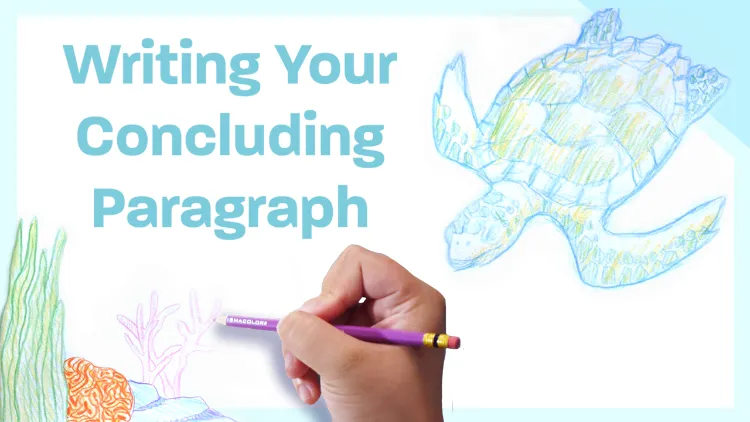
Like any other paper that you write, it's crucial to go back through and revise if you are turning in the final copy. It's extremely rare that you'll write something that doesn't have any mistakes or reworking to do. Once you have written the first draft, take a short break to get your eyes off the paper for just a bit. Come back to the paper after the break with a set of fresh eyes and try to read through it for grammar and spelling mistakes (spell check doesn't get everything!) and then once again for content. Make sure that everything makes sense and is very explanatory. After all—you have to assume that your audience hasn't read your book yet so you want to make sure that you are explaining it well enough to someone who has never read a sentence of it and still be able to understand.
If you are uncertain about sentences or even entire passages of your book report, ask a friend or your instructor to take a look at your work. Sometimes it helps to get an outside opinion since you've been closely working with the text.
Book reports teach us more than just how to write a report
Though we do a lot of research and studying about subjects that may not be applicable after college, book reports may be one of the only exceptions to that. Novels, no matter how abstract the concept, teach us about human behavior and life through plots and characters. Understanding how to break down an author's intent on their stories will absolutely be relevant to your life. Having the curiosity and the skills to understand a novel with a more complex understanding will undoubtedly enrich your reading experience.
Remember than an effective book report will have an introduction that mentions the book title, author, and include the points you will be making throughout the body paragraphs. Your body paragraphs will expand on those ideas that you brought up in the introduction, using quotes from the book, analysis, and summary to aide you.
Finally, be sure that once the book report has been written that you are carefully looking at spelling, grammar, and the content of your paragraphs. Get a friend, your instructor, or even a professional editor to look at your book report to make sure you are on the right track.
Related Posts

How to Write an Efficient and Effective Research Paper Abstract

Annotated Bibliography Examples
- Academic Writing Advice
- All Blog Posts
- Writing Advice
- Admissions Writing Advice
- Book Writing Advice
- Short Story Advice
- Employment Writing Advice
- Business Writing Advice
- Web Content Advice
- Article Writing Advice
- Magazine Writing Advice
- Grammar Advice
- Dialect Advice
- Editing Advice
- Freelance Advice
- Legal Writing Advice
- Poetry Advice
- Graphic Design Advice
- Logo Design Advice
- Translation Advice
- Blog Reviews
- Short Story Award Winners
- Scholarship Winners

Need an academic editor before submitting your work?
Common Sense Media
Movie & TV reviews for parents
- For Parents
- For Educators
- Our Work and Impact
Or browse by category:
- Get the app
- Movie Reviews
- Best Movie Lists
- Best Movies on Netflix, Disney+, and More
Common Sense Selections for Movies

50 Modern Movies All Kids Should Watch Before They're 12

- Best TV Lists
- Best TV Shows on Netflix, Disney+, and More
- Common Sense Selections for TV
- Video Reviews of TV Shows

Best Kids' Shows on Disney+

Best Kids' TV Shows on Netflix
- Book Reviews
- Best Book Lists
- Common Sense Selections for Books

8 Tips for Getting Kids Hooked on Books

- 50 Books All Kids Should Read Before They're 12
- Game Reviews
- Best Game Lists
Common Sense Selections for Games
- Video Reviews of Games

Nintendo Switch Games for Family Fun

- Podcast Reviews
- Best Podcast Lists
Common Sense Selections for Podcasts

Parents' Guide to Podcasts

- App Reviews
- Best App Lists

Social Networking for Teens

Gun-Free Action Game Apps

Reviews for AI Apps and Tools
- YouTube Channel Reviews
- YouTube Kids Channels by Topic

Parents' Ultimate Guide to YouTube Kids

YouTube Kids Channels for Gamers
- Preschoolers (2-4)
- Little Kids (5-7)
- Big Kids (8-9)
- Pre-Teens (10-12)
- Teens (13+)
- Screen Time
- Social Media
- Online Safety
- Identity and Community

Explaining the News to Our Kids
- Family Tech Planners
- Digital Skills
- All Articles
- Latino Culture
- Black Voices
- Asian Stories
- Native Narratives
- LGBTQ+ Pride
- Best of Diverse Representation List

Celebrating Black History Month

Movies and TV Shows with Arab Leads

Celebrate Hip-Hop's 50th Anniversary
"best of" lists.
Get age-appropriate ideas and inspiration for every interest:
- Best Movies for Kids
- Best TV for Kids
- Best Streaming Picks for Kids
- Best Games for Kids
- Best Apps for Kids
- Best Books for Kids
- Best Podcasts for Kids
- Best Websites for Kids
- Best for Character Development for Kids
- Best for Diversity for Kids
- Best for Learning for Kids
The Best Book-Report Books for Middle Schoolers
No need to dread a book report! When kids find titles that are engaging, interesting, and thought-provoking, they're hooked. If it's fiction, students can dissect plot, theme, and characters. If it's nonfiction, they can plunge into a subject that fascinates them or learn a lot about something they've never heard of before. Here's a list of surefire selections for students in sixth, seventh, and eighth grades. For even more ideas, check out 50 Books All Kids Should Read Before They're 12 .

Anne Frank: The Diary of a Young Girl
Inspiring wartime journal reveals teen's inner life.

The Apothecary, Book 1
Cold War kids use magic to save world in brilliant novel.

Everything Sad Is Untrue: (A True Story)
Young refugee's story is told in memories, myths, fables.

Goodbye Stranger
Bittersweet, lovely story of friendship and social media.

Genesis Begins Again
Teen learns to love herself in uplifting tale of misfits.

Hold on tight for an intense tale of survival.

A Long Walk to Water
Touching take on Lost Boys of Sudan, based on true story.

One Crazy Summer
A gem, with strong girl characters, '60s black history.

Poverty, being unhoused explored in hopeful tale.

The Port Chicago 50: Disaster, Mutiny, and the Fight for Civil Rights
Little-known disaster gets overdue, in-depth treatment.

The Red Badge of Courage
Compelling Civil War novel questions morality of battle.

Uglies: Uglies Quartet, Book 1
Thoughtful sci-fi about the price of beauty.

Interned girl, Native boy find common ground in moving tale.

All-American Muslim Girl
Captivating coming-of-age tale explores identity, racism.

American Ace
Moving, fast-paced novel-in-verse; great for teen boys.

Bomb: The Race to Build -- and Steal -- the World's Most Dangerous Weapon
Complex, suspenseful story of developing The Bomb.

The Boys Who Challenged Hitler: Knud Pedersen and the Churchill Club
Thrilling true story of teenagers who stood up to the Nazis.

Enchanted Air: Two Cultures, Two Wings
Poignant memoir-in-verse recalls Cuban American's childhood.

Long Way Down
Gripping, unnerving story of teen boy contemplating revenge.

My Name Is Not Easy
Fascinating story of Alaskan kids growing up in the 1960s.
Other great lists from our editors
- Coming-of-Age Books
- Books to Help Your Kid Survive Middle School
- How to Raise a Reader
- Help Your Kids Find Books with Diverse Characters
- How Comics Helped My Kid Love Reading
- Grades 6-12
- School Leaders
Win Big in Our Teacher Appreciation Giveaway 🎁!
42 Creative Book Report Ideas for Students
Inspire your students to share their love of books.

Responding to what you read is an important literacy skill. Reading about other people’s experiences and perspectives helps kids learn about the world. And although students don’t need to dive deeply into every single book they read, occasionally digging into characters, settings, and themes can help them learn to look beyond the prose. Here are 42 creative book report ideas designed to make reading more meaningful.
1. Concrete Found Poem

This clever activity is basically a shape poem made up of words, phrases, and whole sentences found in the books students read. The words come together to create an image that represents something from the story.
2. Graphic Novel
Have students rewrite the book they are reading, or a chapter of their book, as a graphic novel. Set parameters for the assignment such as including six scenes from the story, three characters, details about the setting, etc. And, of course, include detailed illustrations to accompany the story.
3. Book Snaps

Book Snaps are a way for students to visually show how they are reacting to, processing, and/or connecting with a text. First, students snap a picture of a page in the book they are reading. Then, they add comments, images, highlights, and more.
4. Diary Entry
Have your students place themselves in the shoes of one of the characters from their book and write a first-person diary entry of a critical moment from the story. Ask them to choose a moment in the story where the character has plenty of interaction and emotion to share in a diary entry.
5. Character To-Do List

This fun activity is an off-the-beaten-path way to dive deep into character analysis. Get inside the head of the main character in a book and write a to-do list that they might write. Use actual information from the text, but also make inferences into what that character may wish to accomplish.
6. Mint Tin Book Report

There are so many super-creative, open-ended projects you can use mint tins for. This teacher blogger describes the process of creating book reports using them. There’s even a free template for cards that fit inside.
7. Fictional Yearbook Entries
Ask your students to create a yearbook based on the characters and setting in the book. What do they look like? Cut out magazine pictures to give a good visual image for their school picture. What kind of superlative might they get? Best looking? Class clown? What clubs would they be in or lead? Did they win any awards? It should be obvious from their small yearbooks whether your students dug deep into the characters in their books. They may also learn that who we are as individuals is reflected in what we choose to do with our lives.
8. Book Report Cake

This project would be perfect for a book tasting in your classroom! Each student presents their book report in the shape of food. See the sandwich and pizza options above and check out this blog for more delicious ideas.
9. Current Events Comparison
Have students locate three to five current events articles a character in their book might be interested in. After they’ve found the articles, have them explain why the character would find them interesting and how they relate to the book. Learning about how current events affect time, place, and people is critical to helping develop opinions about what we read and experience in life.
10. Sandwich Book Report

Yum! You’ll notice a lot of our creative book report ideas revolve around food. In this oldie but goodie, each layer of this book report sandwich covers a different element of the book—characters, setting, conflict, etc. A fun adaptation of this project is the book report cheeseburger.
11. Book Alphabet
Choose 15 to 20 alphabet books to help give your students examples of how they work around themes. Then ask your students to create their own Book Alphabet based on the book they read. What artifacts, vocabulary words, and names reflect the important parts of the book? After they find a word to represent each letter, have them write one sentence that explains where the word fits in.
12. Peekaboo Book Report

Using cardboard lap books (or small science report boards), students include details about their book’s main characters, plot, setting, conflict, resolution, etc. Then they draw a head and arms on card stock and attach them to the board from behind to make it look like the main character is peeking over the report.
13. T-Shirt Book Report

Another fun and creative idea: Create a wearable book report with a plain white tee. Come up with your own using Sharpie pens and acrylic paint. Get step-by-step directions .
14. Book Jacket
Have students create a new book jacket for their story. Include an attractive illustrated cover, a summary, a short biography of the author, and a few reviews from readers.
15. Watercolor Rainbow Book Report
This is great for biography research projects. Students cut out a photocopied image of their subject and glue it in the middle. Then, they draw lines from the image to the edges of the paper, like rays of sunshine, and fill in each section with information about the person. As a book report template, the center image could be a copy of the book cover, and each section expands on key information such as character names, theme(s), conflict, resolution, etc.
16. Act the Part
Have students dress up as their favorite character from the book and present an oral book report. If their favorite character is not the main character, retell the story from their point of view.
17. Pizza Box Book Report

If you’re looking for creative book report ideas that use upcycled materials, try this one using a pizza box. It works well for both nonfiction and fiction book reports. The top lid provides a picture of the book cover. Each wedge of the pizza pie tells part of the story.
18. Bookmark
Have students create a custom illustrated bookmark that includes drawings and words from either their favorite chapter or the entire book.
19. Book Reports in a Bag

Looking for book report ideas that really encourage creative thinking? With book reports in a bag, students read a book and write a summary. Then, they decorate a paper grocery bag with a scene from the book, place five items that represent something from the book inside the bag, and present the bag to the class.
20. Reading Lists for Characters
Ask your students to think about a character in their book. What kinds of books might that character like to read? Take them to the library to choose five books the character might have on their to-be-read list. Have them list the books and explain what each book might mean to the character. Post the to-be-read lists for others to see and choose from—there’s nothing like trying out a book character’s style when developing your own identity.
21. File Folder Book Report

Also called a lap book, this easy-to-make book report hits on all the major elements of a book study and gives students a chance to show what they know in a colorful way.
22. Collage
Create a collage using pictures and words that represent different parts of the book. Use old magazines or print pictures from the Internet.
23. Book Report Triorama

Who doesn’t love a multidimensional book report? This image shows a 3D model, but Elisha Ann provides a lesson to show students how to glue four triangles together to make a 4D model.
24. Timeline
Have students create a timeline of the main events from their book. Be sure to include character names and details for each event. Use 8 x 11 sheets of paper taped together or a long portion of bulletin board paper.
25. Clothes Hanger Book Report Mobile

This creative project doesn’t require a fancy or expensive supply list. Students just need an ordinary clothes hanger, strings, and paper. The body of the hanger is used to identify the book, and the cards on the strings dangling below are filled with key elements of the book, like characters, setting, and a summary.
26. Public Service Announcement
If a student has read a book about a cause that affects people, animals, or the environment, teach them about public service announcements . Once they understand what a PSA is, have them research the issue or cause that stood out in the book. Then give them a template for a storyboard so they can create their own PSA. Some students might want to take it a step further and create a video based on their storyboard. Consider sharing their storyboard or video with an organization that supports the cause or issue.
27. Dodecahedron Book Report

Creative book report ideas think outside the box. In this case, it’s a ball! SO much information can be covered on the 12 panels , and it allows students to take a deep dive in a creative way.
28. Character Cards
Make trading cards (like baseball cards) for a few characters from the book. On the front side, draw the character. On the back side, make a list of their character traits and include a quote or two.
29. Book Report Booklets

This clever book report is made from ordinary paper bags. Stack the paper bags on top of each other, fold them in half, and staple the closed-off ends of the bags together. Students can write, draw, and decorate on the paper bag pages. They can also record information on writing or drawing paper and glue the paper onto the pages. The open ends of the bags can be used as pockets to insert photos, cut-outs, postcards, or other flat items that help them tell their story.
30. Letter to the Author
Write a letter to the author of the book. Tell them three things you really liked about the story. Ask three questions about the plot, characters, or anything else you’re curious about.
31. Book Report Charm Bracelet

What a “charming” way to write a book report! Each illustrated bracelet charm captures a character, an event in the plot, setting, or other detail.
32. Fact Sheet
Have students create a list of 10 facts that they learned from reading the book. Have them write the facts in complete sentences, and be sure that each fact is something that they didn’t know before they read the book.
33. Cereal Box TV Book Report

This book report project is a low-tech version of a television made from a cereal box and two paper towel rolls. Students create the viewing screen cut-out at the top, then insert a scroll of paper with writing and illustrations inside the box. When the cardboard roll is rotated, the story unfolds.
34. Be a Character Therapist
Therapists work to uncover their clients’ fears based on their words and actions. When we read books, we must learn to use a character’s actions and dialogue to infer their fears. Many plots revolve around a character’s fear and the work it takes to overcome that fear. Ask students to identify a character’s fear and find 8 to 10 scenes that prove this fear exists. Then have them write about ways the character overcame the fear (or didn’t) in the story. What might the character have done differently?
35. Mind Maps
Mind maps can be a great way to synthesize what students have learned from reading a book. Plus, there are so many ways to approach them. Begin by writing a central idea in the middle of the page. For example, general information, characters, plot, etc. Then branch out from the center with ideas, thoughts, and connections to material from the book.
36. Foldables

From Rainbows Within Reach , this clever idea would be a great introduction to writing book reports. Adapt the flap categories for students at different levels. Adjust the number of categories (or flaps) per the needs of your students.
37. Board games
This is a great project if you want your students to develop a little more insight into what they’re reading. Have them think about the elements of their favorite board games and how they can be adapted to fit this assignment. For more, here are step-by-step directions .
38. Comic strips

If you’re looking for creative book report ideas for students who like graphic novels, try comic strips. Include an illustrated cover with the title and author. The pages of the book should retell the story using dialogue and descriptions of the setting and characters. Of course, no comic book would be complete without copious illustrations and thought bubbles.
39. Timeline
Create a timeline using a long roll of butcher paper, a poster board, or index cards taped together. For each event on the timeline, write a brief description of what happens. Add pictures, clip art, word art, and symbols to make the timeline more lively and colorful.
40. Cereal Box
Recycle a cereal box and create a book report Wheaties-style. Decorate all sides of the box with information about the book’s characters, setting, plot, summary, etc.
41. Wanted Poster

Make a “wanted” poster for one of the book’s main characters. Indicate whether they are wanted dead or alive. Include a picture of the character and a description of what the character is “wanted” for, three examples of the character showing this trait, and a detailed account of where the character was last seen.
42. Movie Version
If the book your students have read has been made into a movie, have them write a report about how the versions are alike and different. If the book has not been made into a movie, have them write a report telling how they would make it into a movie, using specific details from the book.
What creative book report ideas did we miss? Come share in our We Are Teachers HELPLINE group on Facebook.
Plus, check out the most popular kids’ books in every grade..

You Might Also Like

Expand Your Readers’ Palates With a Book Tasting
A perfect way for kids to nibble on a book. Continue Reading
Copyright © 2024. All rights reserved. 5335 Gate Parkway, Jacksonville, FL 32256

Book Report Nonfiction Template
Make it easier to dissect the different sections of the story by editing and customizing this book report nonfiction template from venngage..
- Design style modern
- Colors light
- Size Letter (8.5 x 11 in)
- File type PNG, PDF, PowerPoint
One of the most important parts of reading is understanding the meaning and essence of the book. Dissecting the story into sections and identifying the focal points of each part is crucial to memory retention and reading comprehension. If you want to make reading more fun and enjoyable, a book report outline can help you achieve this goal. A book report nonfiction template can help readers, especially kids, understand and recall the parts of the book better. Non-fiction is a kind of writing based on facts, not fantasy. Non-fiction books talk about events, people, biographies, or historical events that occurred in real life. When reading non-fiction literature, you must always be objective about your approach. Unlike fantasy and make-believe, non-fiction literature relies on facts that trace back to real-life events. Thus, you must always be objective when discussing non-fiction literature. This is where this book report nonfiction template from Venngage becomes handy. Members of academic institutions such as teachers, educators, and librarians can use this book report nonfiction template to create professional-looking, high-quality book reports. Instead of making kids and students write
Read more >
Advertisement
Supported by
Inside MAGA’s Plan to Take Over America
“Finish What We Started,” by the journalist Isaac Arnsdorf, reports from the front lines of the right-wing movement’s strategy to gain power, from the local level on up.
- Share full article

By Jennifer Szalai
- Barnes and Noble
- Books-A-Million
When you purchase an independently reviewed book through our site, we earn an affiliate commission.
FINISH WHAT WE STARTED: The MAGA Movement’s Ground War to End Democracy, by Isaac Arnsdorf
Despite Steve Bannon’s Wall Street pedigree, his taste for five-star hotels and billionaire-owned yachts , he is truly a man of the people — that, at least, is the impression he strains to convey each time he appears in “Finish What We Started: The MAGA Movement’s Ground War to End Democracy,” a new book by Isaac Arnsdorf, a journalist at The Washington Post.
As far as Bannon is concerned, anyone who complains that Donald Trump’s far-right supporters are on the fringes of the fringe, an extremist minority bent on undermining what most Americans actually want, is just a whiner who can go cry some more. As he put it at the Conservative Political Action Conference in the summer of 2022: “All they talk about on MSNBC is ‘democracy, democracy, democracy.’ We’re gonna give them a democracy suppository on Nov. 8!”
The line was classic Bannon: gleeful, bombastic, mildly disgusting. It would also turn out to be wrong. The “red wave” that he and other MAGA enthusiasts envisioned for that year’s midterm elections never materialized; a number of Trump’s handpicked candidates had sailed through their primaries but struggled to prevail in the general election .
Still, Bannon would not be deterred. In the book, he keeps insisting to Arnsdorf that most of the country is MAGA, even if some of those MAGA supporters don’t know it yet. “Bannon believed the MAGA movement, if it could break out of being suppressed and marginalized by the establishment, represented a dominant coalition that could rule for a hundred years,” Arnsdorf writes.
There have been several books about the Trumpification of the Republican Party focused on the politicians and operatives who allowed such a transformation to happen. “Finish What We Started” focuses instead on the ordinary foot soldiers in the MAGA grass roots — the “faces in the crowd” who, in the aftermath of Jan. 6, continued to insist that the 2020 presidential election had been stolen and are determined to never let such an outrage happen again.
The rampage at the Capitol had been spectacular — maybe too spectacular for its own good; what the MAGA movement needed was something stealthier and more tedious, less likely to draw the attention of anyone who would try to thwart it. Arnsdorf recounts how, a month after the attack, Bannon invited a Breitbart blogger named Dan Schultz to his “War Room” podcast to explain what Schultz called “the precinct strategy.” The plan was to take over the Republican Party from the ground up: Get some true MAGA believers into the humble yet foundational building blocks of the party structure — “precinct positions that were often vacant because no one was paying attention.”
Instead of state legislatures staffed by RINOs (Republicans in name only) who had shown themselves too willing to betray the MAGA cause by abiding by the Constitution and certifying the 2020 election, an influx of new precinct committee members would ensure that the 2024 election would reflect the will of the real people — the MAGA faithful.
One person who heeded the message was Salleigh Grubbs, who ran for Republican county chair in Cobb County, Ga., in 2021 and received a phone call from Trump when she won. Arnsdorf juxtaposes Grubbs’s trajectory with that of Kathy Petsas, a Republican Party chair for a legislative district in Maricopa County, Ariz., who went from fielding maybe three applications a month for precinct committee membership to an astonishing 40 a week.
In the months leading up to the 2022 midterms, Petsas was formally reprimanded by her new MAGA colleagues and saw her preferred Republican candidate for Arizona governor get trounced in the primaries by the election-denying, Trump-endorsed Kari Lake; Grubbs, meanwhile, seemed to be flying high on MAGA fumes until she began to grasp “how much more complicated things are, how much you couldn’t see from outside, how there are always unintended consequences.” She still “loved” Trump, but unlike the hard-liners, “she did not worship him.” Arnsdorf describes her growing discomfort with efforts to purge the party’s ranks of anyone who doesn’t toe the new line. Her attempt to speak up for an embattled state chairman gets her booted off a “patriots” group chat.
Arnsdorf mostly hangs back, presenting his subjects’ thoughts in free indirect style. His stated aim is to convey “what makes them believe, what motivates them, what stirs them to action.” Petsas seems baffled by the takeover of her party and clings to the old mode of doing things. Incredulous that the MAGA wing doesn’t think of her as a “real Republican,” she emphasizes her decades of experience as an insider — when that lengthy tenure is obviously considered a mark against her.
Grubbs, for her part, is initially fueled by a sense that official explanations for political results she doesn’t like seem very, very fishy. After Jan. 6, she blasted out a message to her Facebook group: “All. DO NOT BELIEVE THE NEWS. Trump people are not violent. The Capitol protest was fine until Antifa co-opted and committed violence.” She suggests she’s mellowed a bit since becoming a county chair, but mellower MAGA still runs hot. At Georgia’s state Republican convention in 2023, she poses for a photo with Trump and gets a hug from Representative Marjorie Taylor Greene. Grubbs deems it “one of the happiest days of her life.”
Arnsdorf’s book arrives at a moment when Democrats are warning that Trump and the MAGA movement are seeking to end democracy as we know it — and Trump, in his usual I’m-rubber-you’re-glue way , has started to fling the accusation right back . Another new book, “ Minority Rule ,” by Ari Berman, traces in methodical detail the long history of white conservatives deploying all kinds of technical maneuvers to counter the democratic effects of a diversifying country. Jacob Heilbrunn’s excellent “America Last” recounts the American right’s “proclivity for authoritarianism” as reflected in a long record of admiration for foreign dictators. Reading these three books together will give you a sense of how the Republican Party has landed on a plan to entrench power in a pincer movement: minority rule on the one hand and mass radicalization on the other.
It’s a shrewdly cynical way to hedge one’s bets. Bannon’s extravagant bluffing — “ We’re two-thirds of the nation! ” he bragged at CPAC — can’t hide the fact that MAGA extremism is still terribly unpopular. An NBC News poll last year put the share of Americans with a favorable view of the MAGA movement at a meager 24 percent . But consolidating power whenever possible can allow the faithful to “feel some wins,” Arnsdorf writes. Bannon, by constantly telling his listeners that they’re the culmination of democracy instead of its death knell, is feeding them a useful and invigorating delusion. The precinct strategy has become another way of energizing the base.
And the base turns out to have infinite patience for the nitty-gritty of local politics, as long as the ultimate goal is not governance but domination. “Now they understand how important the rules are,” a merry Bannon tells Arnsdorf. “We’re having a civics lesson here. We’re exploding, and the reason we’re exploding? We’re really getting into the granular, and people can’t get enough of it.”
FINISH WHAT WE STARTED : The MAGA Movement’s Ground War to End Democracy | By Isaac Arnsdorf | Little, Brown | 247 pp. | $30
Jennifer Szalai is the nonfiction book critic for The Times. More about Jennifer Szalai
Explore More in Books
Want to know about the best books to read and the latest news start here..
How did fan culture take over? And why is it so scary? Justin Taylor’s novel “Reboot” examines the convergence of entertainment , online arcana and conspiracy theory.
Jamaica Kincaid and Kara Walker unearth botany’s buried history to figure out how our gardens grow.
A new photo book reorients dusty notions of a classic American pastime with a stunning visual celebration of black rodeo.
Two hundred years after his death, this Romantic poet is still worth reading . Here’s what made Lord Byron so great.
Harvard’s recent decision to remove the binding of a notorious volume in its library has thrown fresh light on a shadowy corner of the rare book world.
Bus stations. Traffic stops. Beaches. There’s no telling where you’ll find the next story based in Accra, Ghana’s capital . Peace Adzo Medie shares some of her favorites.
Each week, top authors and critics join the Book Review’s podcast to talk about the latest news in the literary world. Listen here .
Watch CBS News
The Book Report: Washington Post critic Ron Charles (April 28)
By Ron Charles
Updated on: April 28, 2024 / 8:56 AM EDT / CBS News
By Washington Post book critic Ron Charles
Here are four new books to check out this spring.

In 2016, the world fell in love with an immensely charming novel by Amor Towles, called "A Gentleman in Moscow." And now, with the adaptation starring Ewan McGregor streaming on Showtime, anticipation is running high for Towles' next book.
Step this way: "Table for Two" is an irresistible collection of short stories and a novella split between New York and Los Angeles. Flavored with wit, intrigue, and a dash of bitter fate, "Table for Two" demonstrates that Towles is just as masterful at preparing a full literary meal as he is a tart little dessert.
Read an excerpt: "Table for Two"
"Table for Two" by Amor Towles (Viking), in Hardcover, eBook and Audio formats, available via Amazon , Barnes & Noble and Bookshop.org
amortowles.com
Amor Towles on "A Gentleman in Moscow" ("Sunday Morning")
Book excerpt: "A Gentleman in Moscow"
Book excerpt: "The Lincoln Highway"

Leif Enger's debut novel, "Peace Like a River" was released more than 20 years ago, but I've never forgotten its buoyant optimism. Well, things are heating up in Enger's dystopian new novel, "I Cheerfully Refuse."
It's about a man on Lake Superior who's happy and hopeful, even though the government and the climate are wrecked. When violence hits home, though, he's forced to flee, sailing around the Great Lake looking for a place to dock in a world that's burning up and going mad. How he manages to do that is just one of several miracles in this strange, alluring novel.
Read an excerpt: "I Cheerfully Refuse"
"I Cheerfully Refuse" by Leif Enger (Grove Press), in Hardcover, eBook and Audio formats, available via Amazon , Barnes & Noble and Bookshop.org
leifenger.com

So far, American readers have not paid enough attention to Sunjeev Sahota, but in England he's been nominate for the Booker Prize twice.
His brilliant new novel, "The Spoiled Heart," is about an ambitious, well-liked man named Nayan who's running to be the leader of his labor union. He's widely expected to win the election, but then a young woman announces her candidacy, and devastating secrets from Nayan's past begin to arise and cracks appear in his campaign – until he finds himself at odds with the culture he once championed.
Read an excerpt: "The Spoiled Heart"
"The Spoiled Heart" by Sunjeev Sahota (Viking), in Hardcover, eBook and Audio formats, available via Amazon , Barnes & Noble and Bookshop.org

Judi Dench, master of film, TV and stage, has been bringing Shakespeare's plays alive for more than 60 years.
And now, at the age of 89, Dench steals the show again with a delightful new memoir, called "Shakespeare: The Man Who Pays the Rent."
Compiled from conversations with her friend, the actor Brendan O'Hea, this is a treasure trove of wit and wisdom about a unique relationship between an incomparable actress and the immortal playwright who still sets her heart ablaze.
Read an excerpt: "Shakespeare: The Man Who Pays the Rent"
"Shakespeare: The Man Who Pays the Rent" by Judi Dench and Brendan O'Hea (Macmillan), in Hardcover, eBook and Audio formats, available via Amazon , Barnes & Noble and
Bookshop.org
For more suggestions on what to read, contact your librarian or local bookseller.
That's it for the Book Report. I'm Ron Charles. Until next time, read on!
For more info:
- Ron Charles, The Washington Post
- Subscribe to the free Washington Post Book World Newsletter
- Ron Charles' Totally Hip Video Book Review
- Bookshop.org (for ordering from independent booksellers)
For more reading recommendations, check out these previous Book Report features from Ron Charles:
- The Book Report (March 17)
- The Book Report (February 18)
- Ron Charles' favorite novels of 2023
- The Book Report (October 22)
- The Book Report (September 17)
- The Book Report (August 6)
- The Book Report (June 4)
- The Book Report (April 30)
- The Book Report (March 19)
- The Book Report (February 12, 2023)
- The Book Report: Ron Charles' favorite novels of 2022
- The Book Report (November 13)
- The Book Report (Sept. 18)
- The Book Report (July 10)
- The Book Report (April 17)
- The Book Report (March 13)
- The Book Report (February 6, 2022)
- The Book Report (November 28)
- The Book Report (September 26)
- The Book Report (August 1)
- The Book Report (June 6)
- The Book Report (May 9)
- The Book Report (March 28)
- The Book Report (February 28)
- The Book Report (January 31, 2021)
Produced by Robin Sanders and Roman Feeser.
- Books and Beyond
More from CBS News
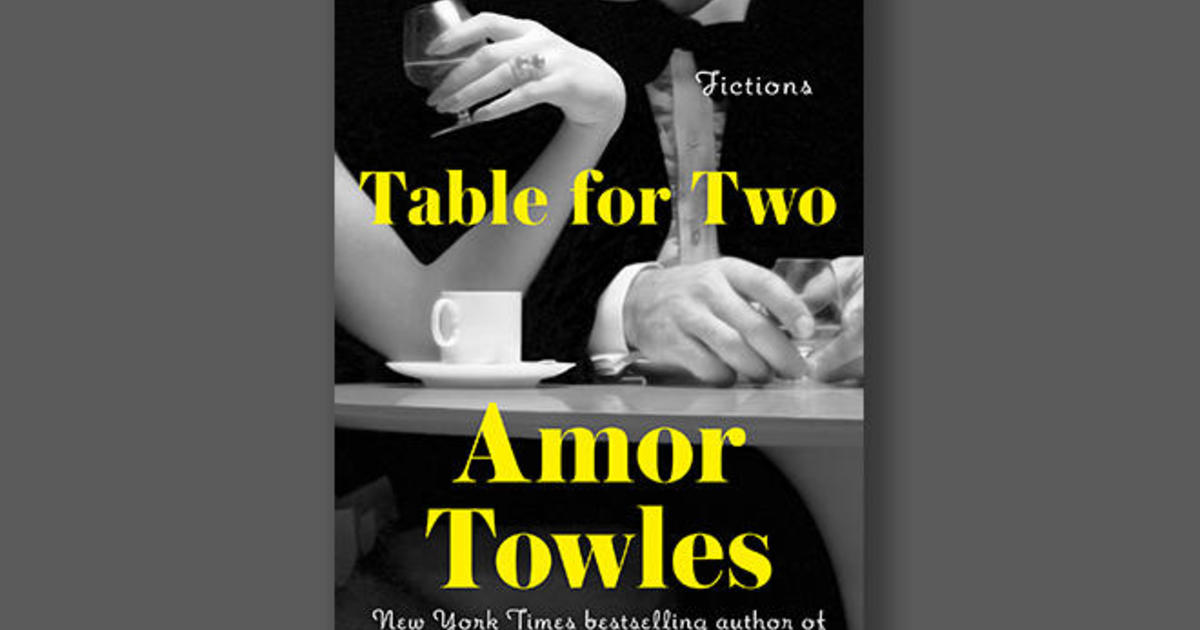
Book excerpt: "Table for Two" by Amor Towles
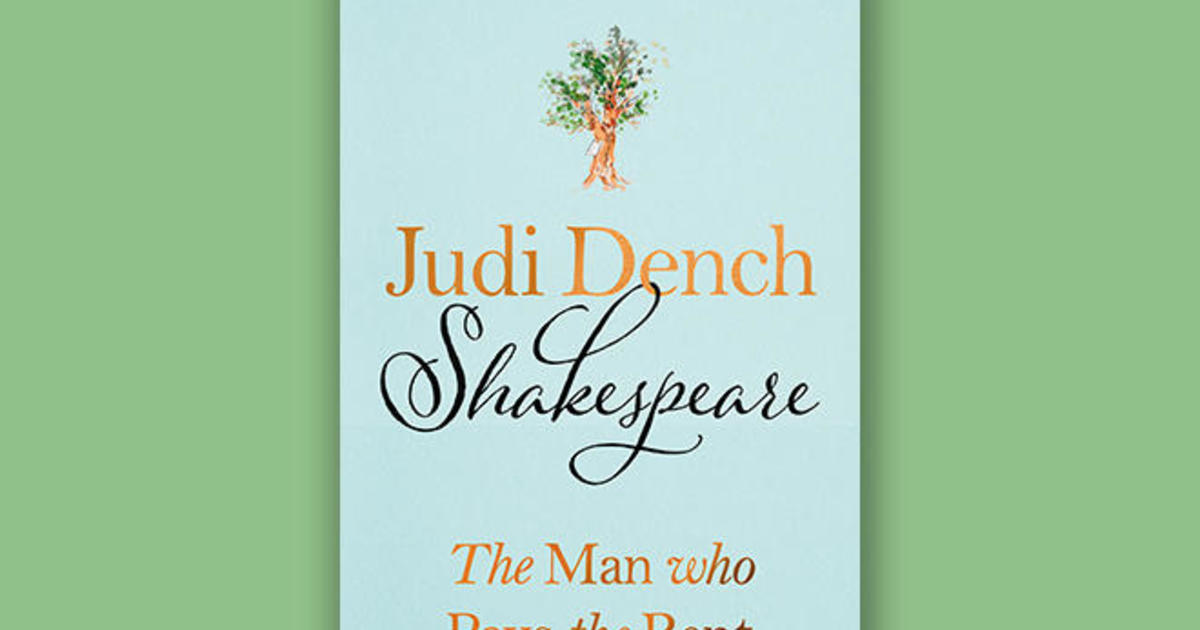
Book excerpt: Judi Dench's love letter to Shakespeare
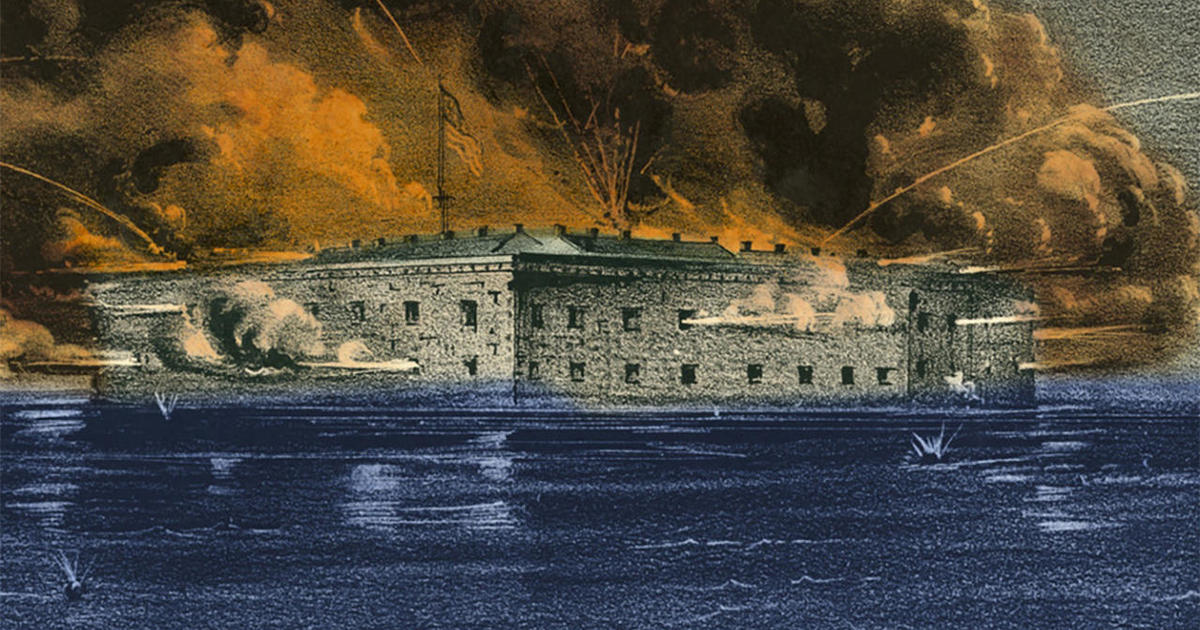
"The Demon of Unrest": Recounting the first shots of the Civil War
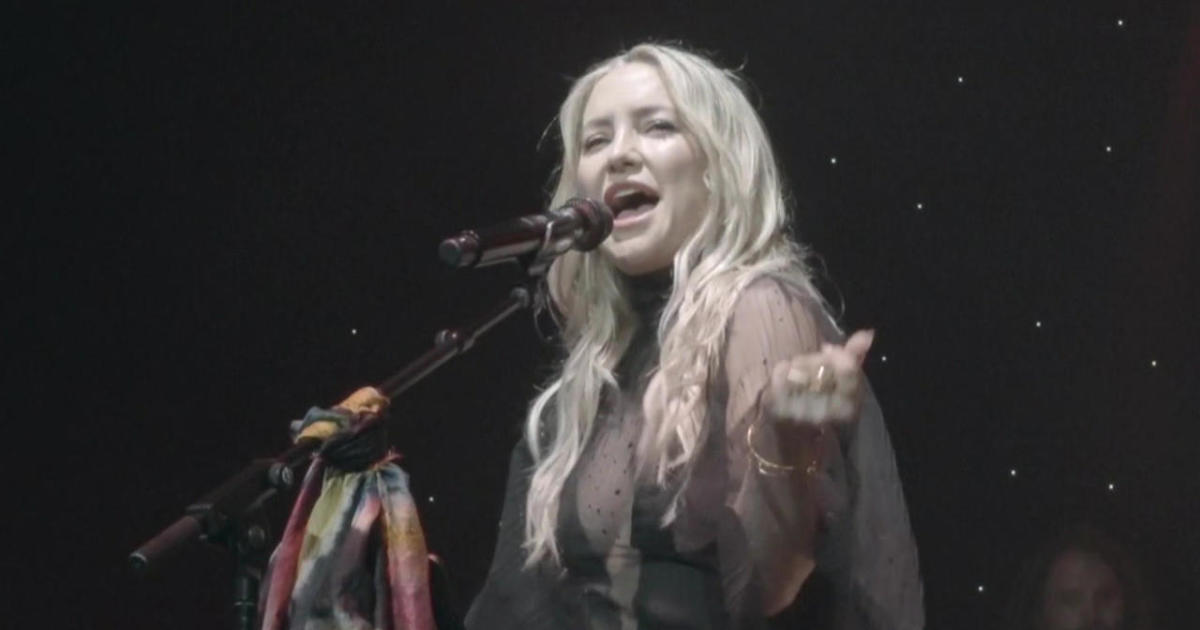
Kate Hudson on her "Glorious" album

Vitals News & Events
- Announcements
- Construction Website
- Construction Project Dates / Timeline
- Construction Maps / Directions
- Construction Contacts & Help Desk
- Library Services
- Yoga at the Library
- Eccles Library COVID-19 Updates
- Library Site
- Technology Hub
- Priscilla M. Mayden Lecture
- Domestic & Sexual Violence Resources

EHSL Vitals News and Events
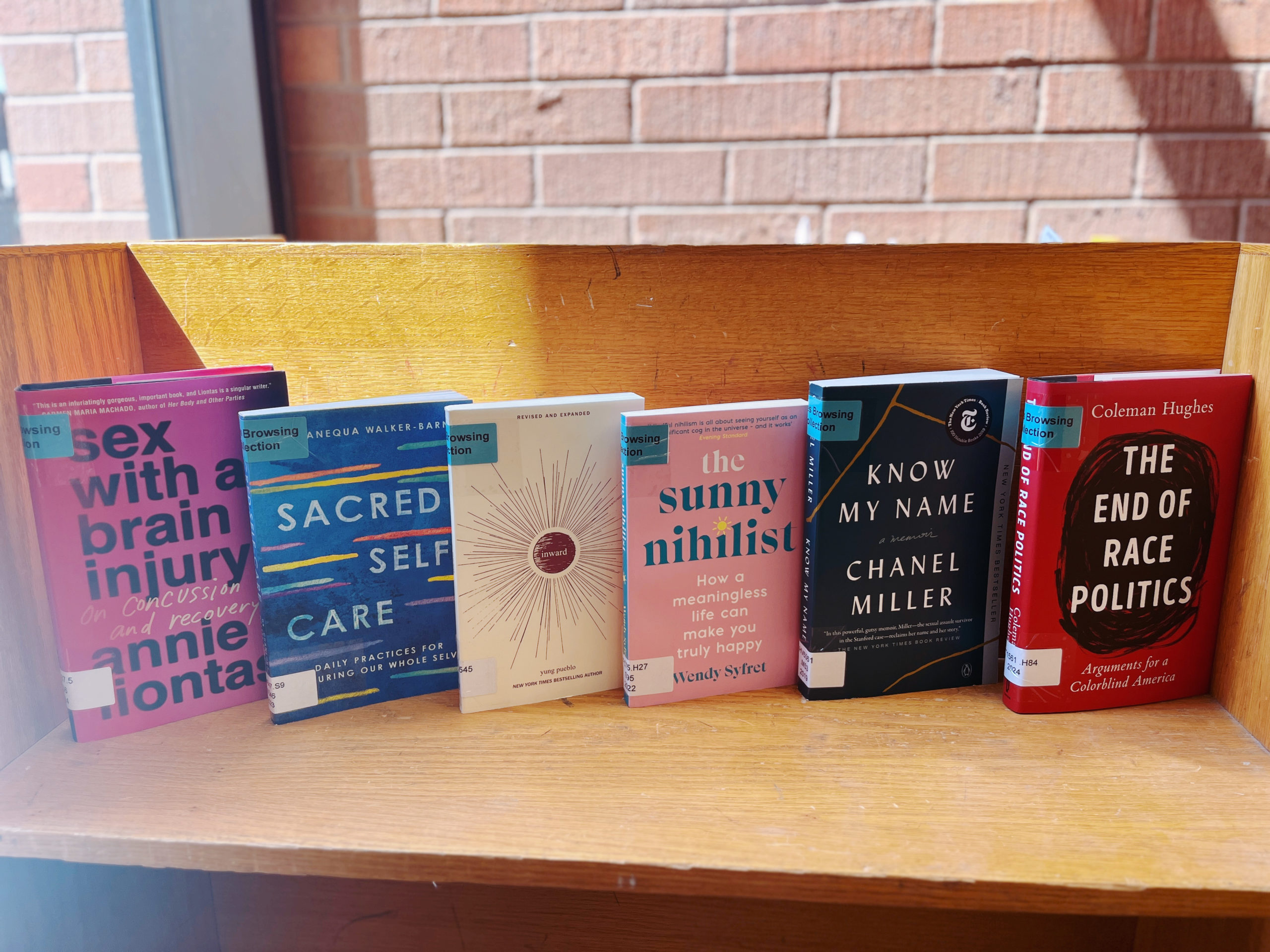
New Titles, April 2024
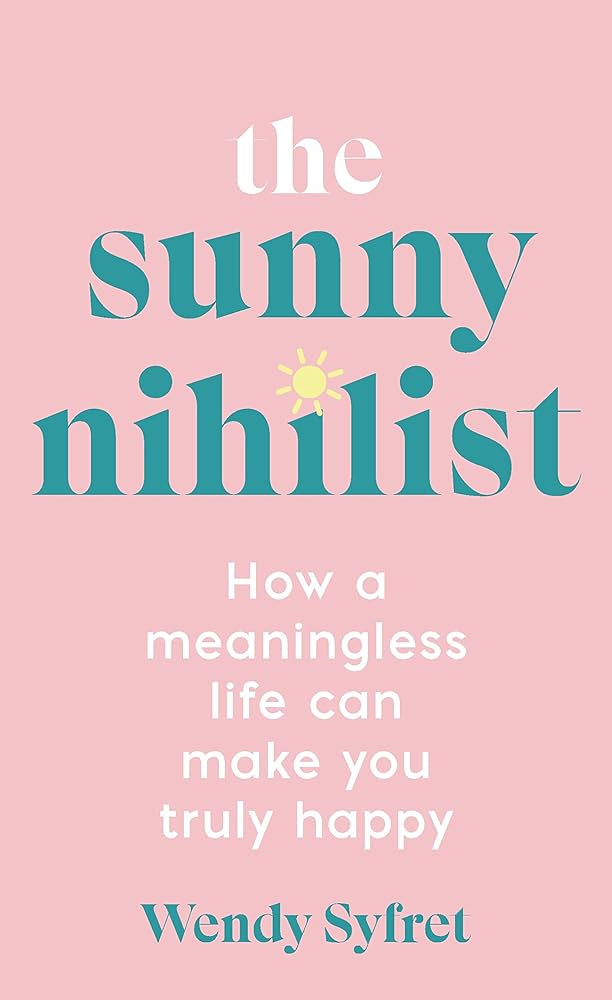
The Sunny Nihilist: How a Meaningless Life Can Make You Truly Happy – Wendy Syfret | Nonfiction
A Declaration of the Pleasure of Pointlessness .
Wendy Syfret is a nihilist, or rather, a sunny nihilist. Nihilism often has a negative connotation. After explaining the history and nuances of nihilism, Syfret explores the ways in which nihilism can be reworked into a form of coping or consolation through appreciation of “the little things.” She warmly encourages readers to take action: live in the present to enjoy your life and instead of falling victim to apathy, reframe feelings of being small to leave the world better than you found it.
Further reading: How to be a happy nihilist an article by Wendy Syfret.
Know My Name – Chanel Miller | Memoir
Trigger warnings: sexual assault, gaslighting, graphic content
Know My Name is a disturbing, raw recounting of Chanel Miller’s sexual assault by Brock Turner at Stanford University in 2015, and subsequent trial. The title of her memoir is fitting – as the nation knows the name of the perpetrator but not the victim. Over the course of years, Miller grapples with a biases, the criminal justice system, and trauma. Through healing and writing, Chanel Miller takes her name back by proving that she is not just a victim, but a complex person; a writer, an artist, and a fighter.
“ Know My Name is a gut-punch, and in the end, somehow, also blessedly hopeful.” –Washington Post
Review by The New York Times
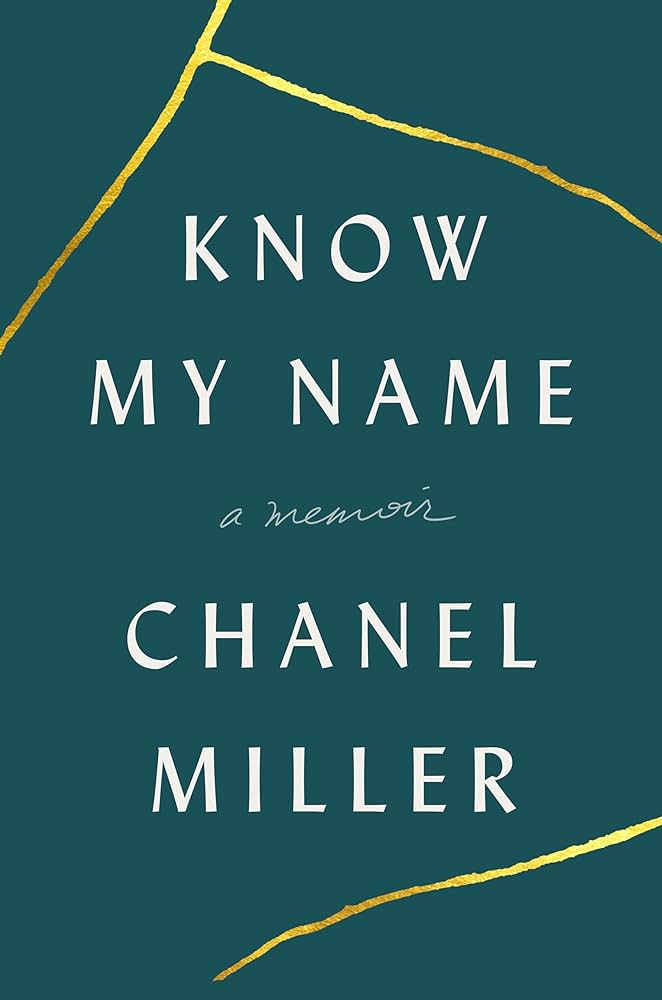
Sacred Self-Care: Daily Practices for Nurturing Our Whole Selves – Dr. Chanequa Walker-Barnes | Self-Help
This book is a seven-week guide designed by psychologist and theologian, Dr. Walker-Barnes, to help readers in developing lifelong habits that encompass mind, body, and soul. Dr. Walker-Barnes encourages readers to consider self-care as divine right and sacred obligation.
Each day in the guide includes a short story and prompts to help readers shift their mindsets.
- Mastering the Self-Care Fundamentals
- Practicing Self-Compassion
- Setting Healthy Boundaries
- Caring for Our Emotional Selves
- Caring for Our Minds
- Practicing Self-Care as a Way of Life
Sex With a Brain Injury: On Concussion and Recovery – Annie Liontas | Memoir
In her thirties, Annie Liontas sustained multiple brain injuries, which led to strange problems, such as an increased sense of smell, extreme fatigue, confusion, dizziness, and more. Liontas’ head trauma inspires her to learn more about the phenomenon, as there is very little research done on TBIs (traumatic brain injuries). She learns that most studies done on TBIs do not include women or queer people and that 50-80% of incarcerated people have gotten at least one TBI.
This book is excellent for readers who have experienced TBI themselves, or for readers who are close to someone with a TBI.
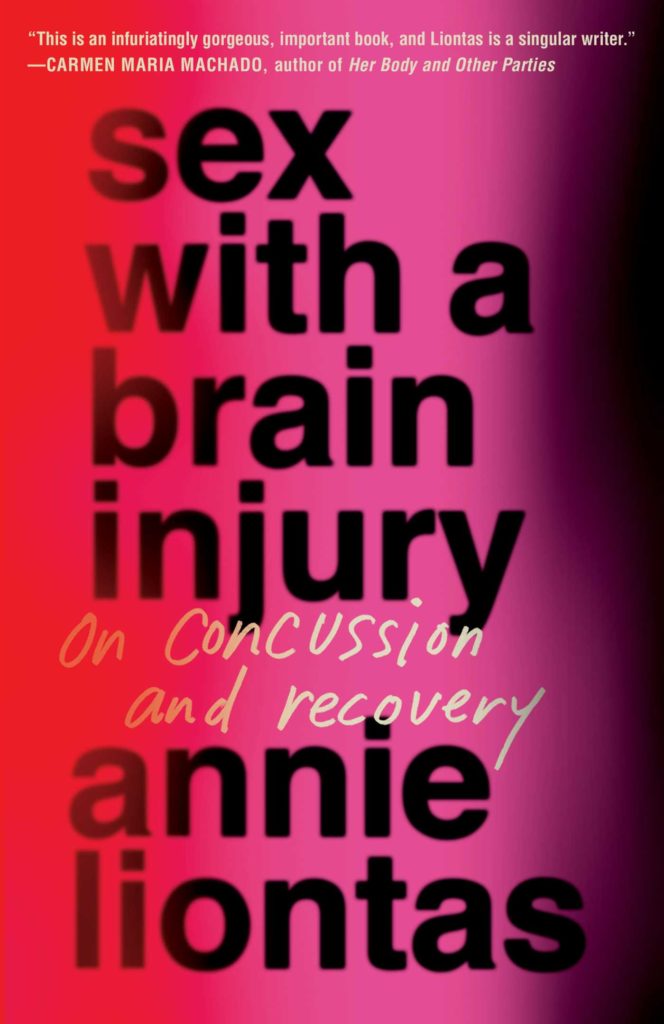
Inward – Yung Pueblo | Poetry
A collection of meditative poems written by Diego Perez under his pen name of Yung Pueblo, which means “young people”
Inward is the first in a series. This installment explores self-love and how that intertwines with letting go and learning about oneself.
Perez has now written 4 books, with his most recent release in October of 2023 – The Way Forward .
The End of Race Politics: Arguments for a Colorblind America – Coleman Hughes | Nonfiction
In Hughes’ first book, he warns that the antiracist movement is actually driving society toward a new kind of racism. As one of very few Black students in his philosophy program at Columbia University, he wondered why his peers were more pessimistic about racism in America than his grandparents, who lived through segregation. Calling back to the ideals that originally inspired the American Civil Rights movement, he offers the ways a colorblind and racially just culture could be possible.
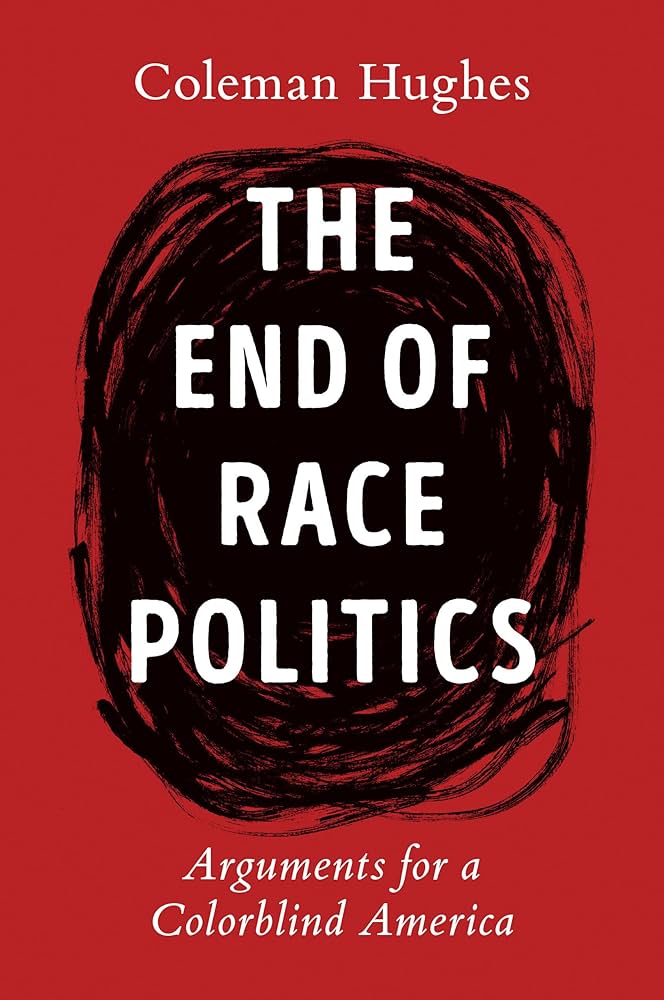
Related Posts
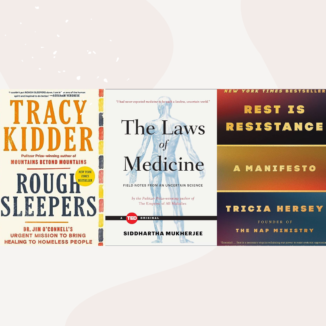
New Books: Fall 2023

Fall in Love with Books
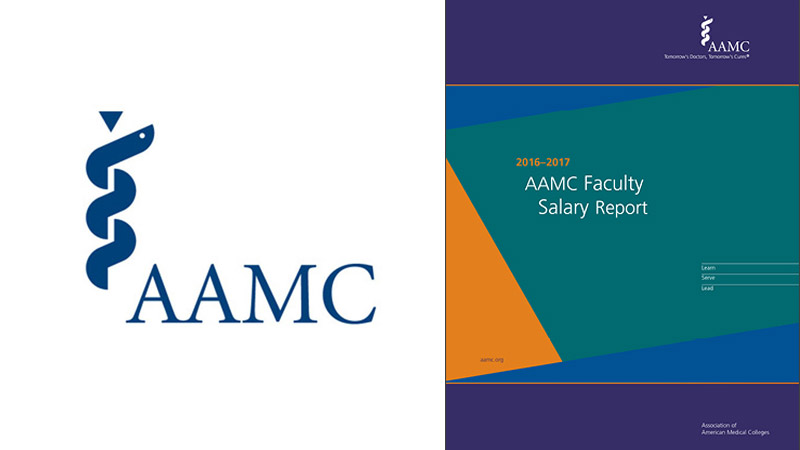
AAMC Faculty Salary Report Available at Eccles Library
The ama manual of style is now available online from eccles library.
Spencer S. Eccles Health Sciences Library, University of Utah, brand
- © 1993 – Spencer S. Eccles Health Sciences Library
- Spencer S. Eccles Health Sciences Library
- The University of Utah
- 10 N. 1900 E. Salt Lake City, UT 84112
- Phone 801.581.5534


IMAGES
VIDEO
COMMENTS
Describe: The Facts of the Non Fiction Book Report. Description in a book report includes names and major points in the book. This is not the time to state your analysis of the work but simply to list the relevant information so the reader knows where your analysis will go. The information in the description portion of a nonfiction book report ...
Include the title and author in your intro, then summarize the plot, main characters, and setting of the book. Analyze the author's writing style, as well as the main themes and arguments of the book. Include quotes and examples to support your statements. Part 1.
The Non-Fiction Report Definition. It is a kind of book report when your task is to write about a nonfiction book. Many genres are depending on the discipline you study and the requirements of the particular instructor. You may read historic literature, philosophy pieces, self-help books, books about science, space, famous people, and so on.
3. Organize your notes and create an outline. Gather your notes and arrange them into categories. Once you've completed this, write an outline and organize the categories to become the paragraphs of your book report. Jot down bullet points on what each paragraph will include and what part of the book can support it.
Example 2: Non-Fiction Book Report Title: "Sapiens: A Brief History of Humankind" by Yuval Noah Harari. Introduction: "Sapiens: A Brief History of Humankind" by Yuval Noah Harari is a thought-provoking journey through the evolution of Homo sapiens, from ancient ancestors to the present. As a new author delving into non-fiction, the task ...
Book reports remain a key educational assessment tool from elementary school through college. Sitting down to close read and critique texts for their content and form is a lifelong skill, one that benefits all of us well beyond our school years. With the help of this guide, you'll develop your reading comprehension and note-taking skills. ...
2. Identify the main elements of the book. Scrutinize the book's primary components, including its main themes, characters, setting, and plot. These elements will form the basis of your report. 3. Formulate a thesis statement. Compose a thesis statement that encapsulates your personal perspective about the book.
Develop the body: You can follow your outline or a book report template to write the body of your report. Discuss each element (plot, characters, themes, etc.) in separate paragraphs or sections. Conclude your report: Summarize your main points and offer your final thoughts and evaluation of the book. Review and revise: Finally, review and ...
Structure your essay using an outline. The introduction to your report should include the author's name, year of publication and reason for writing the nonfiction novel, if applicable. Hook the reader in the first sentence with an interesting opening, and summarize in a line or two the main theme of the novel to set up the rest of your report ...
Here are quick steps to create a book report: Consult Summary Websites: Visit websites providing book summaries and analyses. For instance, SparkNotes or CliffsNotes offer concise overviews. Focus on Key Details: Select 2-3 crucial aspects of the book, like major themes or character development. Discuss these in-depth.
Generally, when we think of book reports, we think of fiction reading response. However, nonfiction book report templates serve equally as important of a purpose for digging deep into nonfiction texts. Book reports are such a great way to encourage the use of many different reading skills with the same text.
Add animation, interactivity, audio, video and links. Download in PDF, JPG, PNG and HTML5 format. Create page-turners with Visme's flipbook effect. Share online with a link or embed it on your website. Create a fantastic non-fiction book report using this excellent design or browse Visme's exceptional range of report templates for more ideas.
Non-Fiction Book Report Template. Non-Fiction Book Report Template. Description. Streamline your book report writing with our pre-made template! Cover all the crucial aspects of the book including plot summary, character analysis, and personal opinions. A must-have resource for efficient and effective reporting.
Non-fiction book reports. If your students are writing their report on a non-fiction book, the main body of the report should include a description of the topic and a summary of the author's opinions and arguments. Rather than reporting on every argument or point raised in the text, students should pick the main points they wish to cover. ...
Book reports commonly describe what happens in a work; their focus is primarily on giving an account of the major plot, characters, thesis, and/or main idea of the work. Most often, book reports are a K-12 assignment and range from 250 to 500 words. Book reviews are most often a college assignment, but they also appear in many professional ...
Make writing a book report on a work of non-fiction a little easier with this template. Click here: bookreport_nonfiction-download.doc to download the document. EW Lesson Plans. More than 1,000 FREE Lessons Reading, Writing, Math, Science, History & Every-Day Edits!
Elementary Book Reports Made Easy An easy one-page pdf download of a book report worksheet that would be good for elementary students. Printable Book Report Forms (Non-Fiction, Fiction, Biography, Mystery & Fable) You have lots of different options for book report templates. Whether or not you need a book report form for a biography, non ...
For example, if we were writing an introduction about a book report over Harper Lee's To Kill a Mockingbird, we might write something like this:. In Harper Lee's iconic coming of age novel, To Kill a Mockingbird, Lee confronts the audience with the idea that systemic racism was rampant in the U.S. court system in the early 20th century in the South.
My Name Is Not Easy. age 12+. Fascinating story of Alaskan kids growing up in the 1960s. By: Debby Dahl Edwardson (2011) See full review. Common Sense Media editors help you choose The Best Book-Report Books for Middle Schoolers. Find fiction, nonfiction, and memoirs perfect for engaging kids.
1Have students write their topic at the top of a sheet of paper and the letters of the alphabet, A to Z, down the left side. 2Invite students to think of a fact about their topic for each letter. They can play with words to make their facts fit. For instance, "E—Eucalyptus leaves are a staple of the koala's diet.
17. Pizza Box Book Report Mrs. Suggs/pizza box via X (formerly Twitter) If you're looking for creative book report ideas that use upcycled materials, try this one using a pizza box. It works well for both nonfiction and fiction book reports. The top lid provides a picture of the book cover. Each wedge of the pizza pie tells part of the story ...
A book report nonfiction template can help readers, especially kids, understand and recall the parts of the book better. Non-fiction is a kind of writing based on facts, not fantasy. Non-fiction books talk about events, people, biographies, or historical events that occurred in real life.
"Finish What We Started," by the journalist Isaac Arnsdorf, reports from the front lines of the right-wing movement's strategy to gain power, from the local level on up.
This month's fiction and non-fiction titles include the follow-up from Amor Towles, author of the international sensation, "A Gentleman in Moscow." ... 4/28: The Book Report by Washington Post ...
Sacred Self-Care: Daily Practices for Nurturing Our Whole Selves - Dr. Chanequa Walker-Barnes | Self-Help . This book is a seven-week guide designed by psychologist and theologian, Dr. Walker-Barnes, to help readers in developing lifelong habits that encompass mind, body, and soul. Dr. Walker-Barnes encourages readers to consider self-care as divine right and sacred obligation.